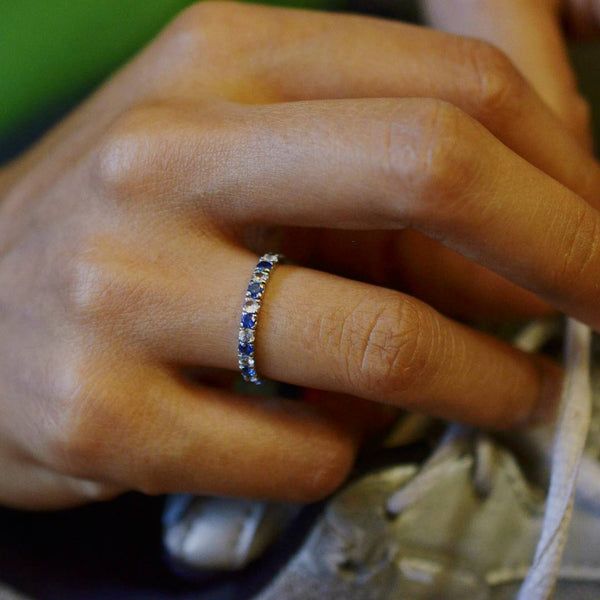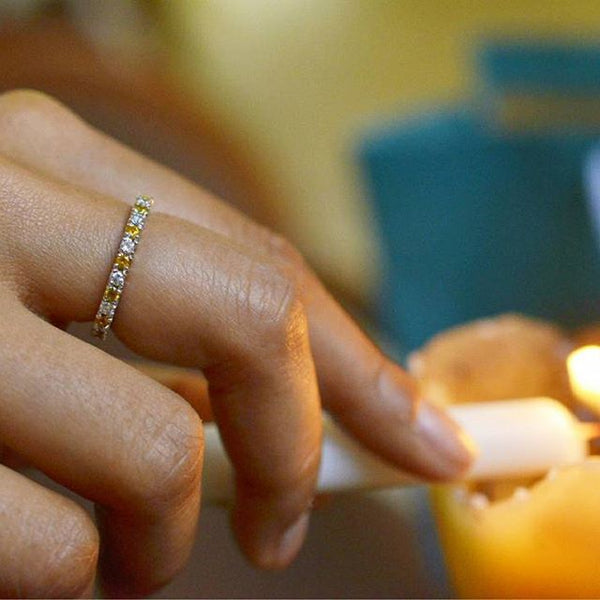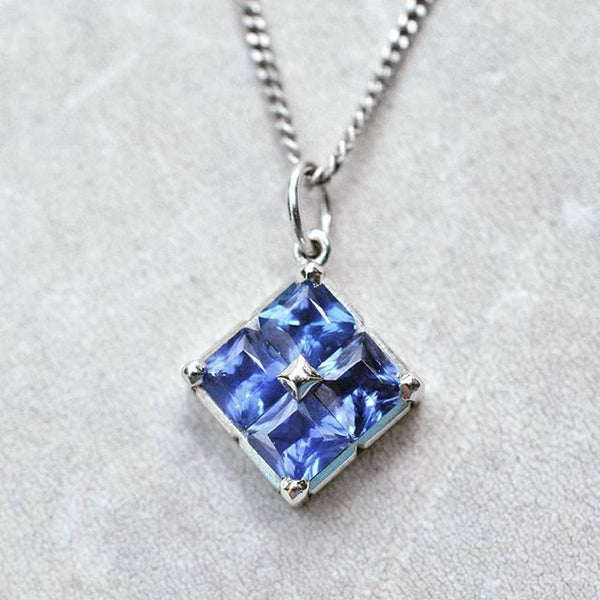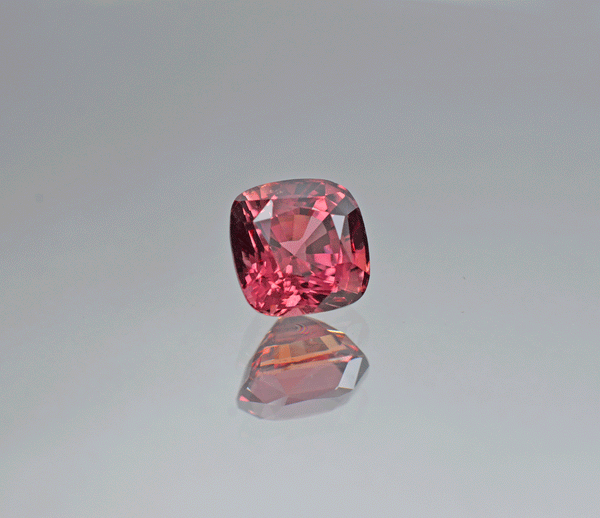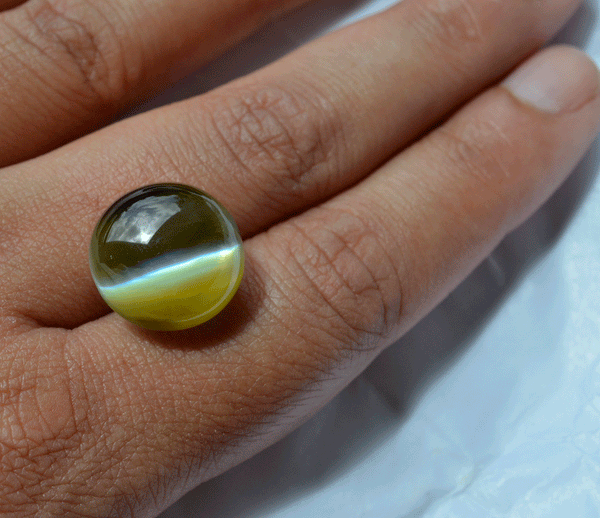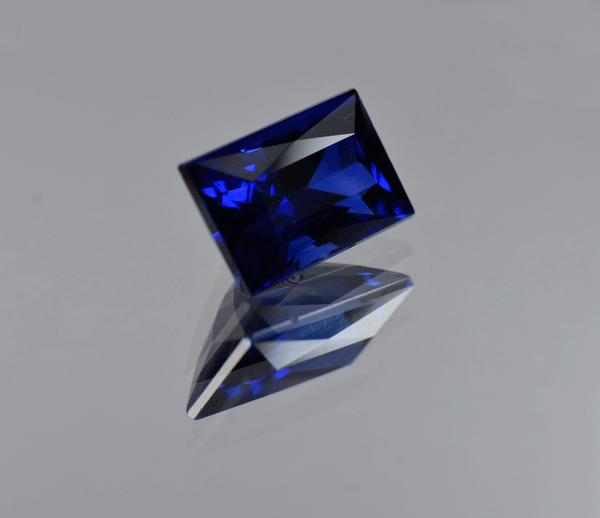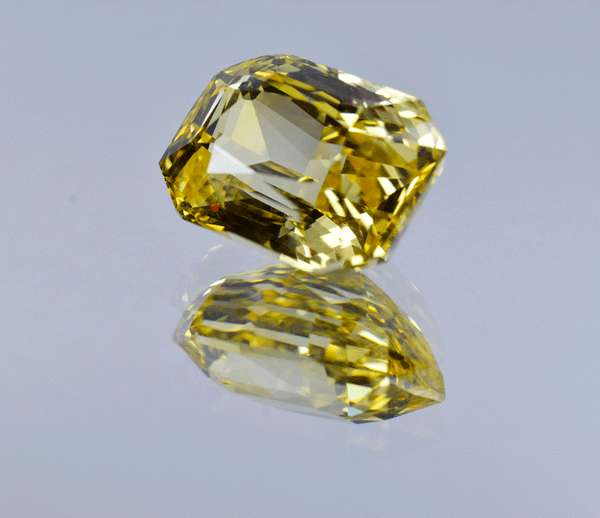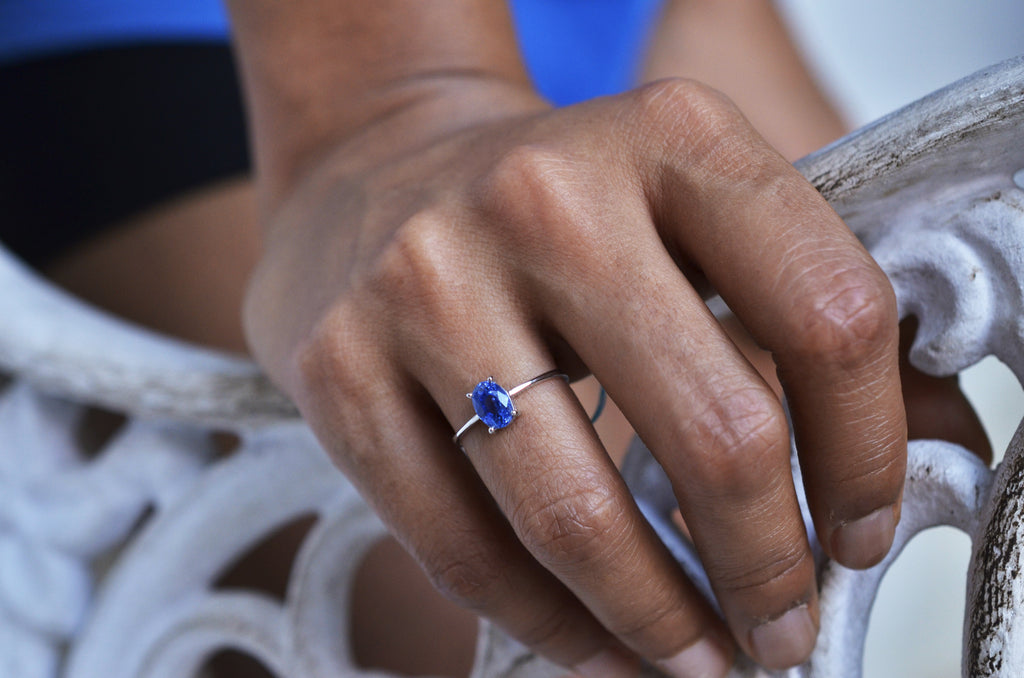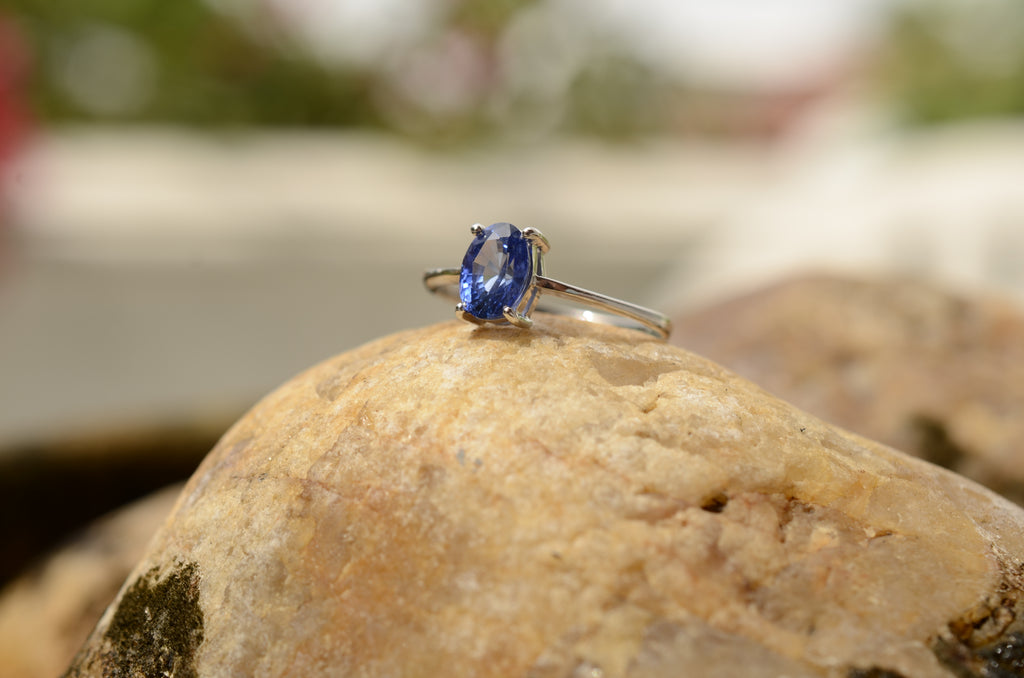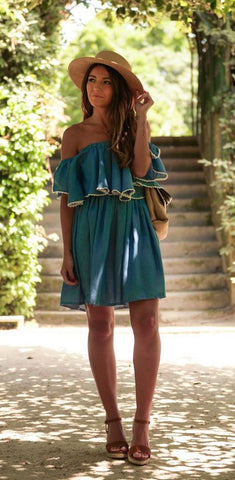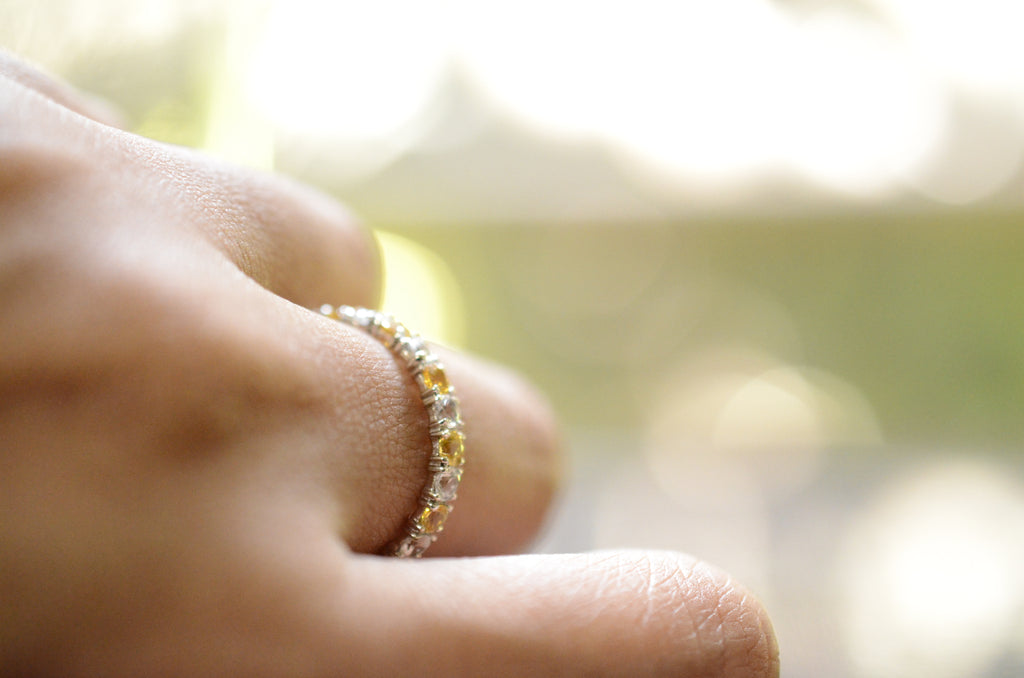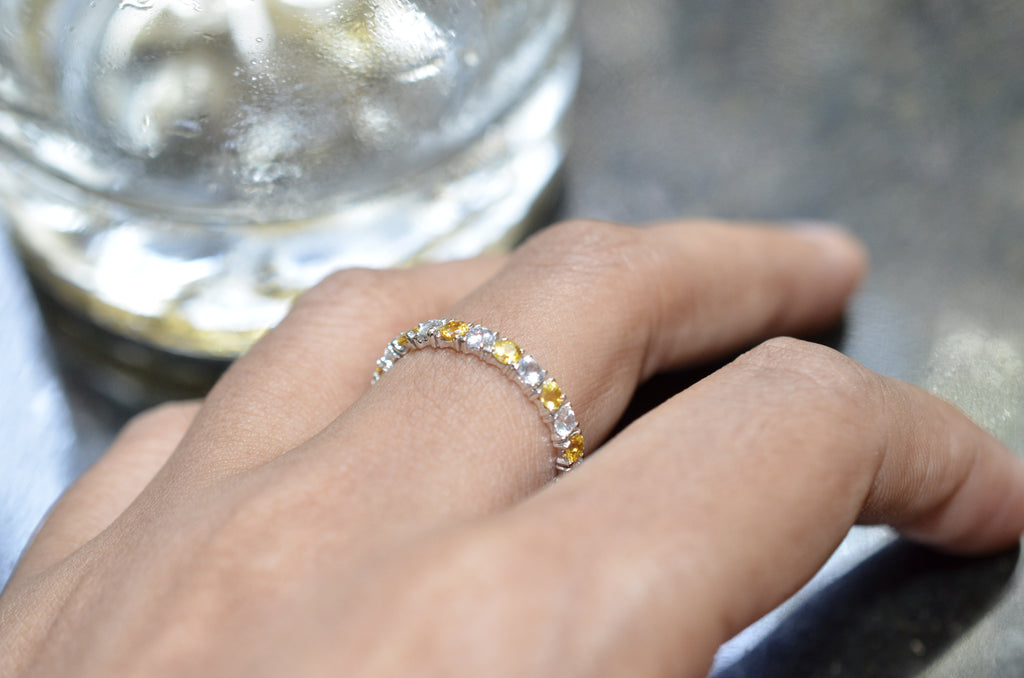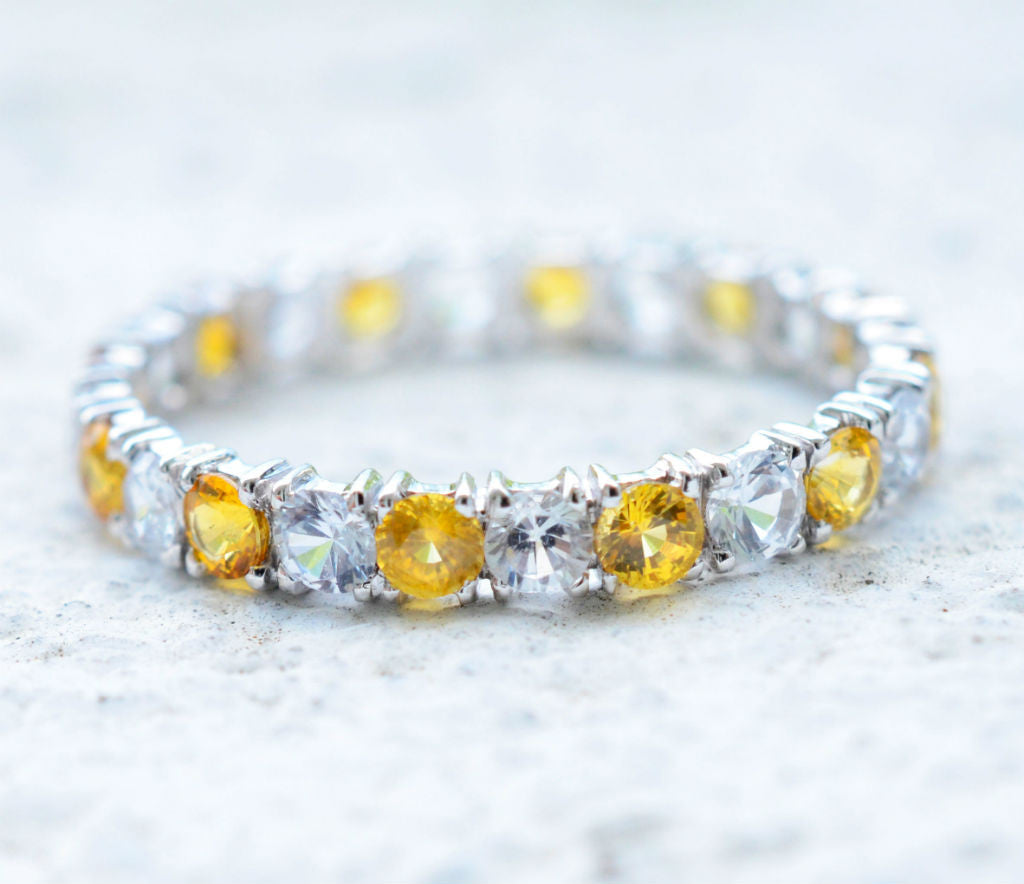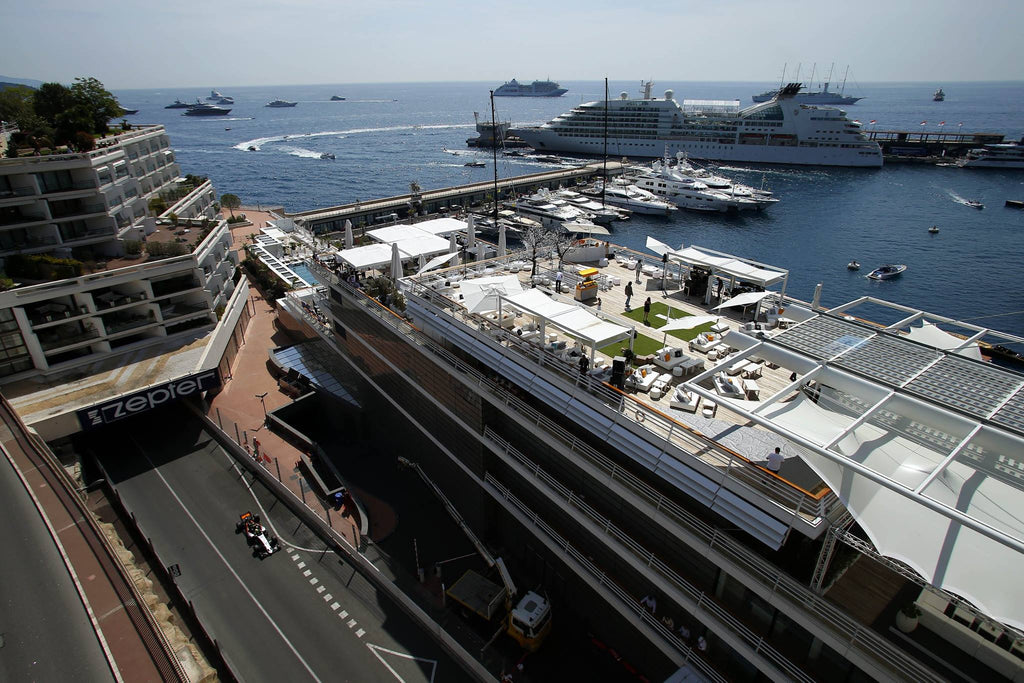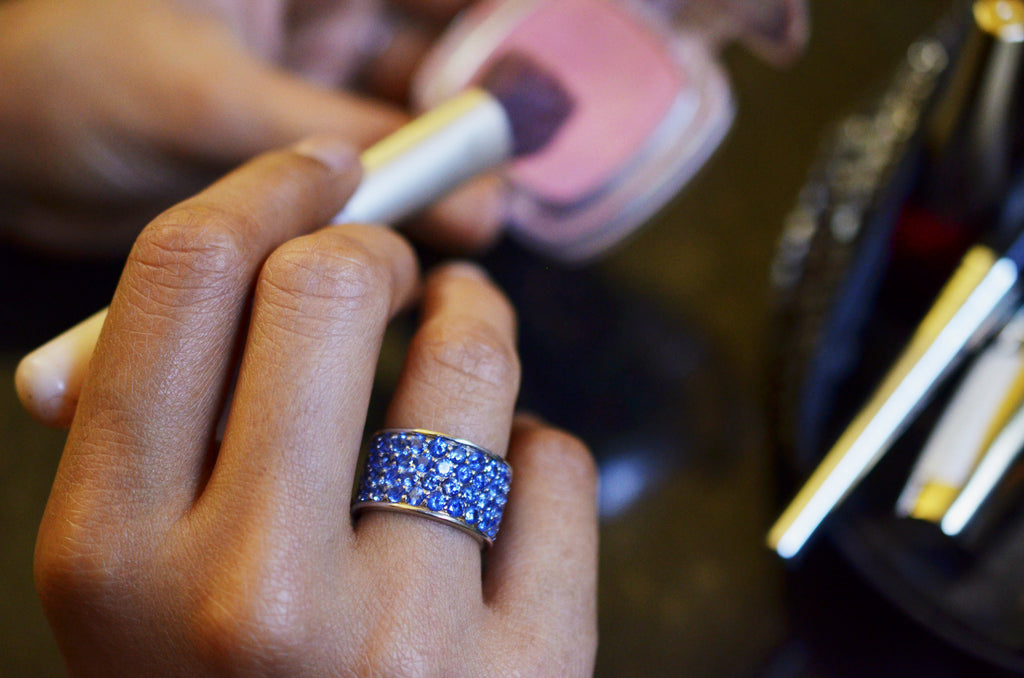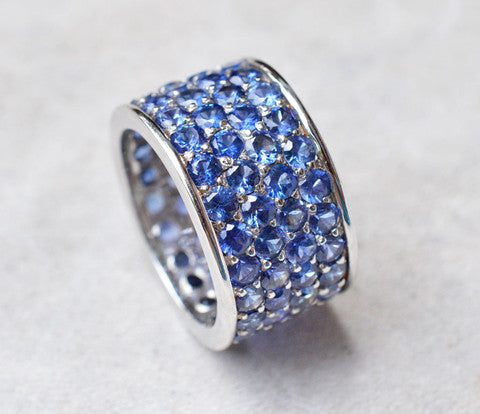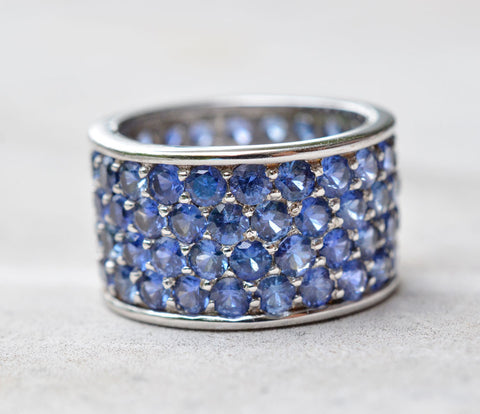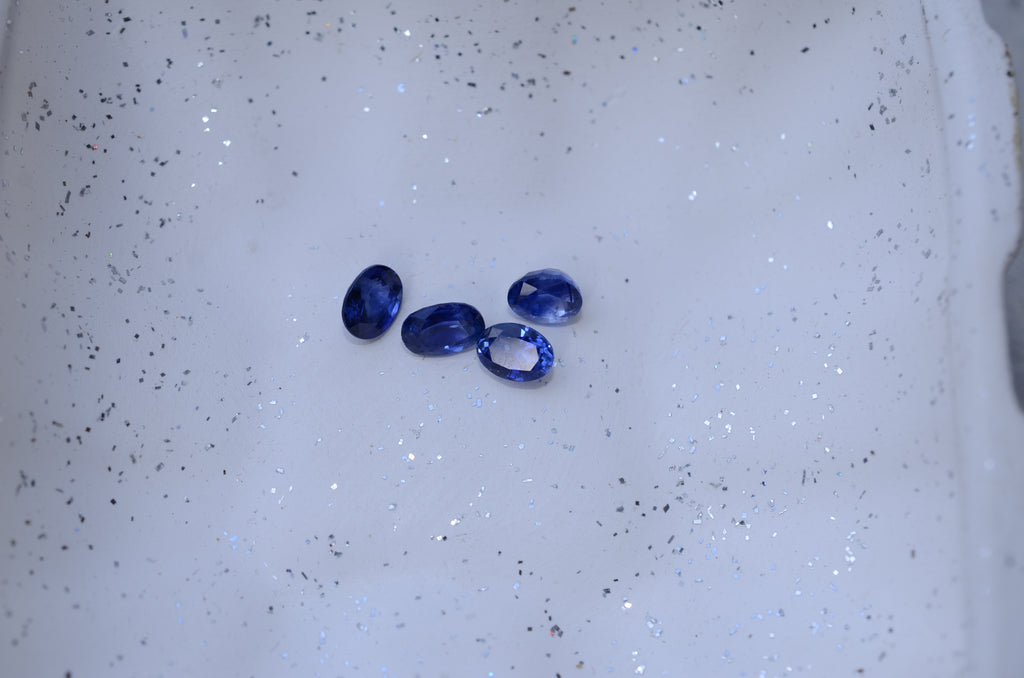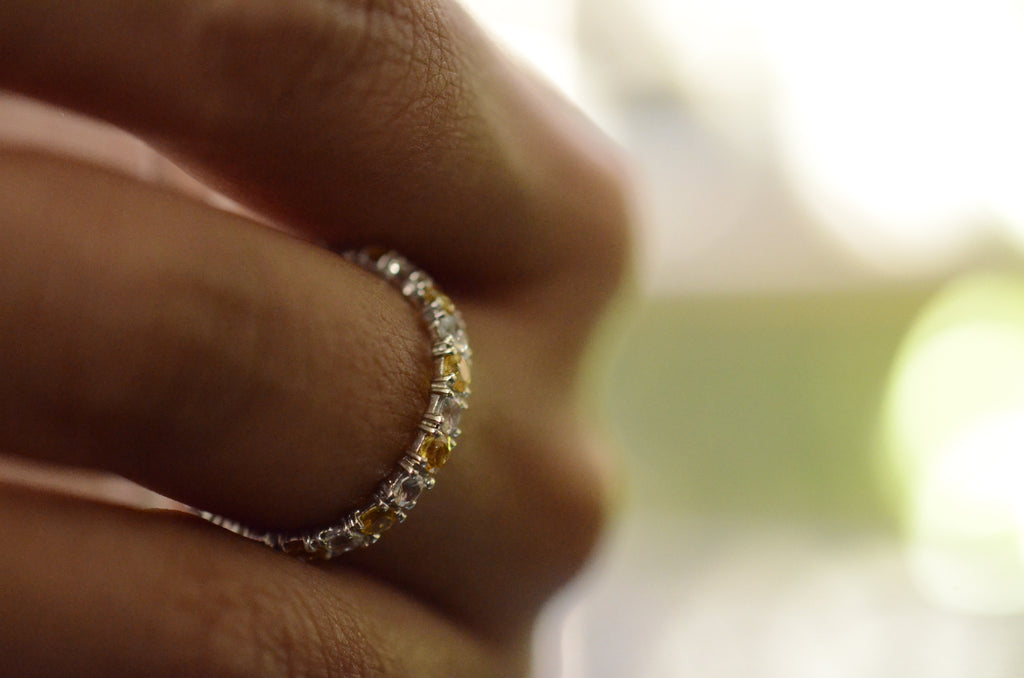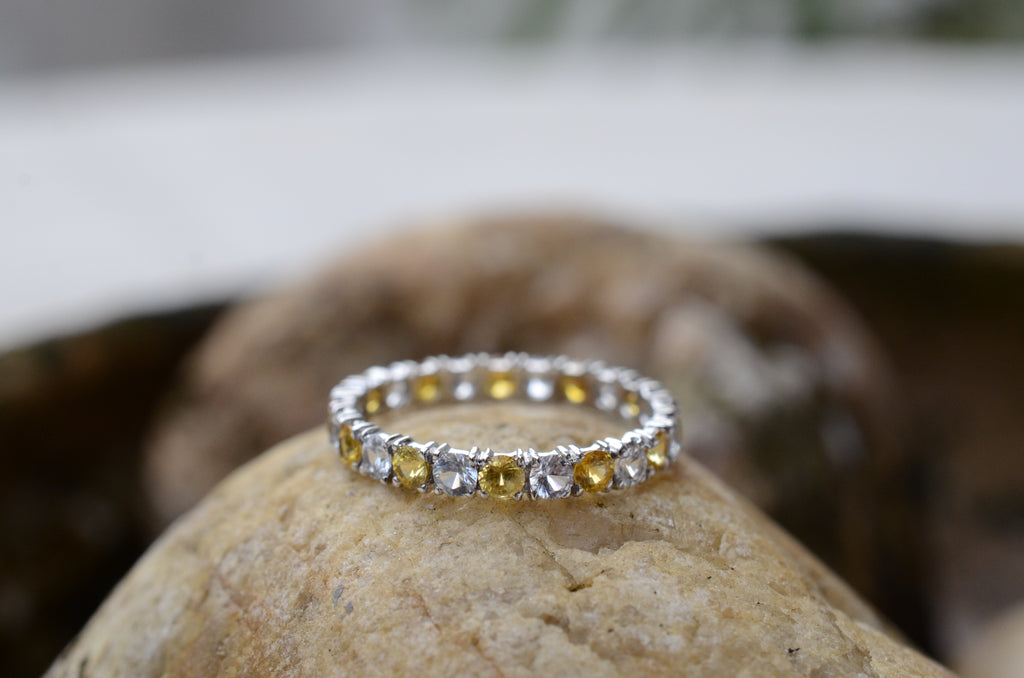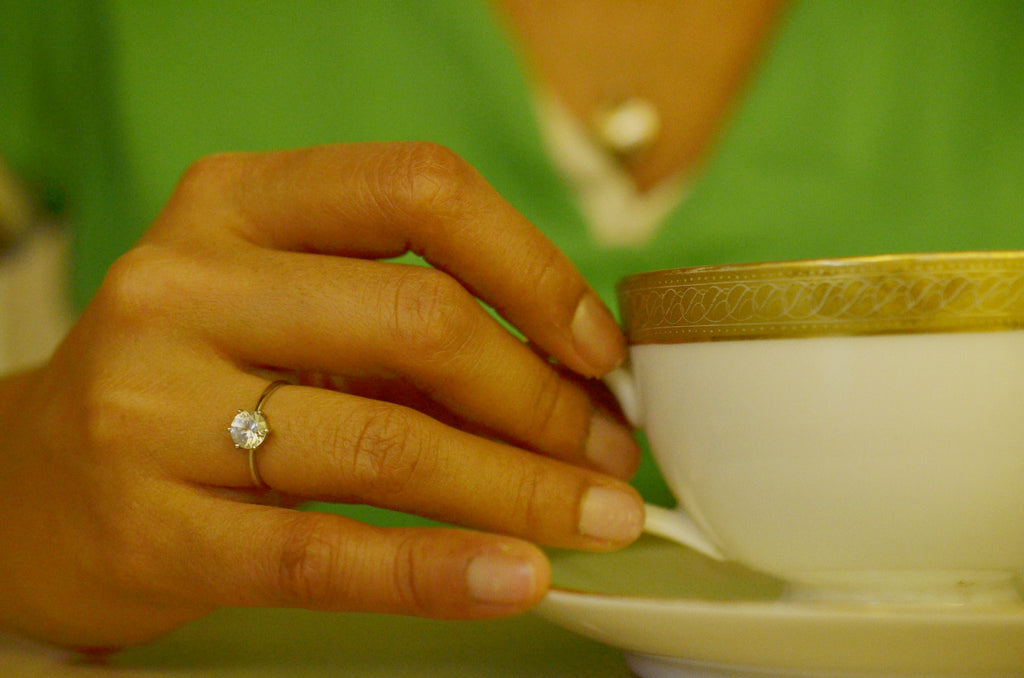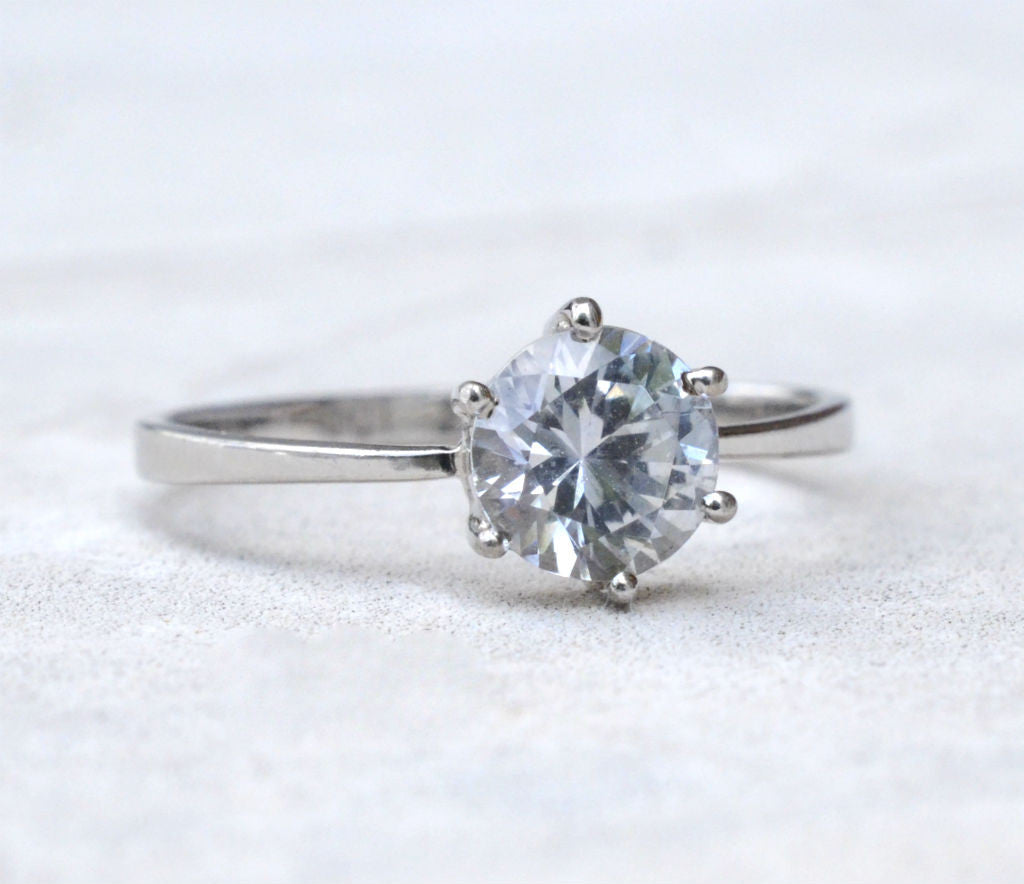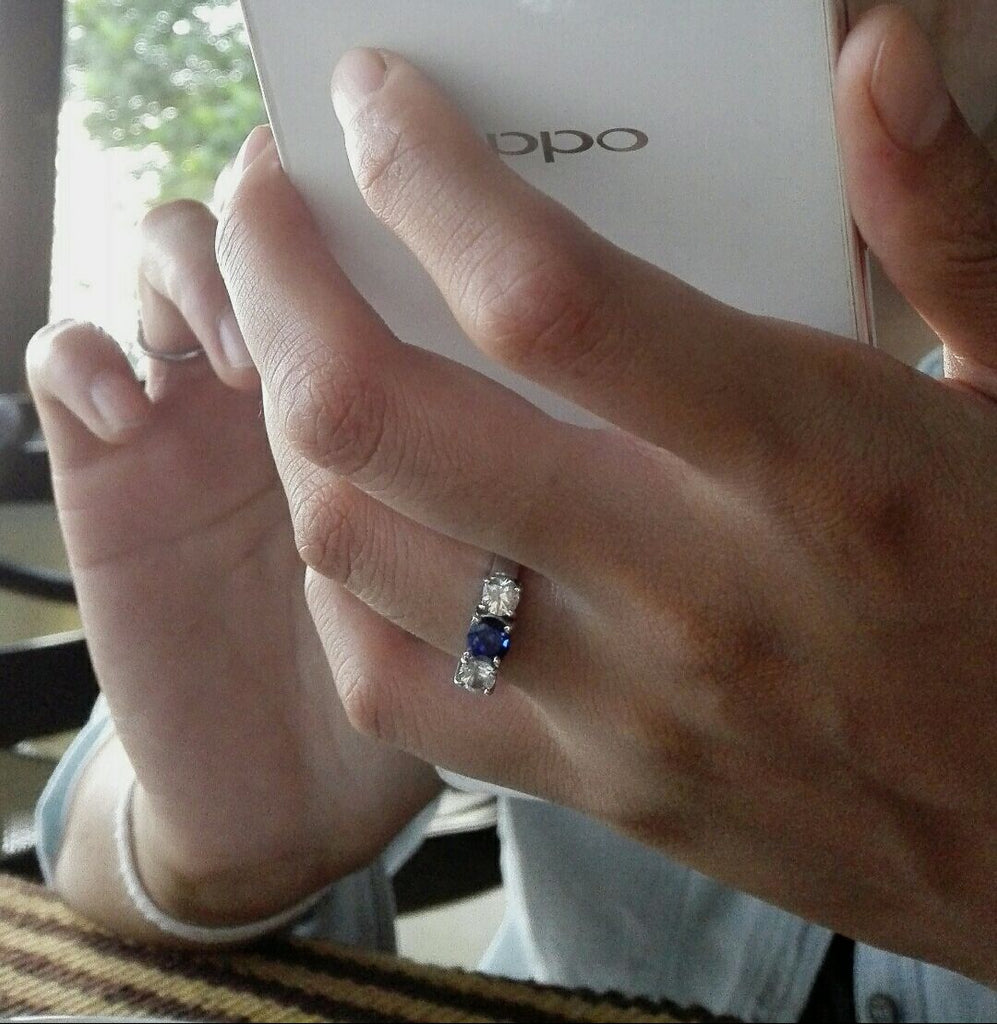Sapphire Jewelry and Sri Lanka (Ceylon)
Everyday Jewelry October 09 2017
The Gem Investment April 27 2017
Precious gemstones have served as vehicles of value for millennia. Sapphires, diamonds, emeralds and rubies are great choices as investment alternatives to the stock market or sports memorabilia; their intrinsic value remains relatively stable over time and do not burden you with hundreds of dollars of storage costs. These gemstones are attractive and are always in demand and so, being armed with a few investment tips and a bit of patience, can easily protect the wealth you’ve earned.
When purchasing gemstones as an investment, you often make your money when you buy them! More often than not, the average rate of return you can come to expect from a gemstone is the rate of inflation unless it has a unique and special history to its name based on past ownership. As a result, in order to lock in a return that is worth the risk you are willing to take, gemstones would need to be purchased below the retail price you intend to sell them at. This would involve finding primary wholesalers (those who are in the business of mining gemstones), secondary wholesalers (those who act as intermediaries between the primary wholesaler and the retailers) or open market auctions through estate sales and pawnshops to make your purchase.
Making the purchase is just as important. Consulting with a trained professional who has an eye out for the value of a gemstone is highly advised as it will determine the quality of the gemstone you are going to purchase. Each sapphire and diamond is unique and so being able to ascertain slight differences in their cut, clarity, color and carat size will help ensure that you pay the right amount based on an objective appraisal. Of course, with experience and attention to detail, you too can become an excellent appraiser of gemstone value and this not only help reduce the costs of acquiring professional services but also serves as a great skill you could use to impress your friends at a cocktail party!
Once you’ve purchased your gemstone and you are ready to make the sale, it is unlikely that you can go into a store and get the prevailing market price like it is for gold and silver. Gemstones are simply not readily liquid as its value is determined by a variety of factors that need careful examination such as its quality and the amount the buyer is willing to pay. Instead, you will have to organize and handle all the logistics and negotiations of the trade with other willing buyers, auction houses or stores. The upside of this autonomy is that you have the choice to add value to the gemstone you are selling. Utilizing a reputed lapidary or gem cutter to re-cut, re-polish or establish a setting will help generate a return far in excess of your initial cost base and pave the way to grow your investment.
In essence, gemstones are excellent alternative investments and serve as a class of assets that can help you diversify and protect your wealth. As is with most things, the more you understand about gemstones you will be investing in, the easier it will become to grow and consolidate your portfolio. It is very much like running your very own business than investing in a financial instrument, so enjoy the ride and good luck!
The Origins of Synthetic Gemstones April 27 2017
Synthetic gems are ones that have been forged in the confines of a laboratory yet share all of the physical, chemical and optical traits of their natural counterparts. The first gem crystal of faceting quality to be synthesized was in fact a ruby and their production since the late 1800s has largely been as a result of its industrial applications outside of the jewelry industry. Its production can be engineered to remove virtually all of the flaws present within its counterparts’ natural lattice structure. Coupled with the increasing ability to manufacture ‘to order’, these synthetic gems have come under fire recently for being easily confused with naturally occurring gemstones.
During the past two centuries, scientists have derived an assortment of methods to create gem crystals in the laboratory. A large proportion of them fall into two main categories: melt or solution processes. In the melt process, the chemical composition of the melt is the same as that of the resulting crystal whereas in the solution process, the melt is of a different chemical composition. High temperatures are used to dissolve a variety of constituents into the melt or solution and then it is gradually cooled as the crystal grows from a seed like structure.
The Verneuil process was the first successful commercially viable production method for producing synthetic gems using the melt process. It was developed in 1902 by the French scientist, Auguste Verneuil and it involves dropping powdered chemicals through a downward directed flame, where it melts and forms a crystal on a rotating pedestal. It has become the most inexpensive method of manufacturing synthetic crystals such as corundum and is widely used across industries. An example of the solution process is the hydrothermal growth method. It is the only known method of rowing synthetic quartz but is requires a large investment in equipment, skilled technicians and patience. The method dissolves a mixture of nutrients into a water solution and immerses it into a specialized container that mimics the intense heat and pressure present deep inside the outer core of the earth where natural gems form. Once cooled in a controlled manner, this solution precipitates crystals that are near identical to Mother Nature’s own creations.
Synthetic sapphire crystals have been utilized in a wide array of applications from shatter resistant windows in armored vehicles to insulating substrates in integrated circuits used in computers, telephones and satellite communication systems. One particular use, sapphire glass, has seen a lot of media exposure recently given its use in many Apple products including their smart watches. Its versatility as a material derives from its ability to be highly transparent across a wide optical range (from ultraviolet to infrared wavelengths) and being highly resistant to scratching and abrasion than standard glass.
Given that synthetic gem crystals can have a remarkable similarity to naturally occurring gemstones, strict regulations are set in place to control how they are marketed and sold. For example, the Federal Trade Commission in the U.S. mandates the description of synthetic gem crystals to leave no doubt that it is not produced naturally. Other regulatory agencies such as the International Colored Gemstone Association (ICA) and the World Jewellery Confederation (CIBJO) have issued strict procedures that disclose the synthetic gemstone’s origin throughout the distribution channel at the time of sale, from the manufacturer to the consumer. In the past few decades, fewer and fewer synthetic gems have been marketed which suggests that its repertoire is nearing its limit but nonetheless, a careful eye is placed to ensure a fair and honest trade at every point of sale.
The Sapphire Jubilee April 27 2017
Queen Elizabeth II celebrated her Sapphire Jubilee on the 6th of February 2017 to become the first British Monarch to reign for 65 years! Sapphires have been used around the world as a gemstone to allure, command authority, heal the afflicted and influence one’s destiny but no one has used it to the splendor of the British Monarchy and in particular, Queen Elizabeth II. Hence, we focused our next blog on the magnificent collection of sapphires in Queen Elizabeth II’s Sapphire Jubilee.
George VI Victorian Suite
The George VI Victorian Suite is an elegant set of jewelry that originally consisted of 18 stunning blue sapphires in a necklace that were surrounded by clusters of diamonds. It was created by Carrington & Co. in 1850 and was gifted to the Queen by her father, King George VI, upon her marriage to Prince Phillip of Greece in 1947. This jewelry set includes some of the Queens most beloved sapphire gemstones and she had made a few adjustments to it in 1959 to make the largest sapphire stone fit as a pendant as well as a brooch. In 1963, the Queen also commissioned a matching tiara and bracelet which she featured in many occasions including her Royal State visit to the United States in 1991 and the Diplomatic Reception at Buckingham Palace in 2016.
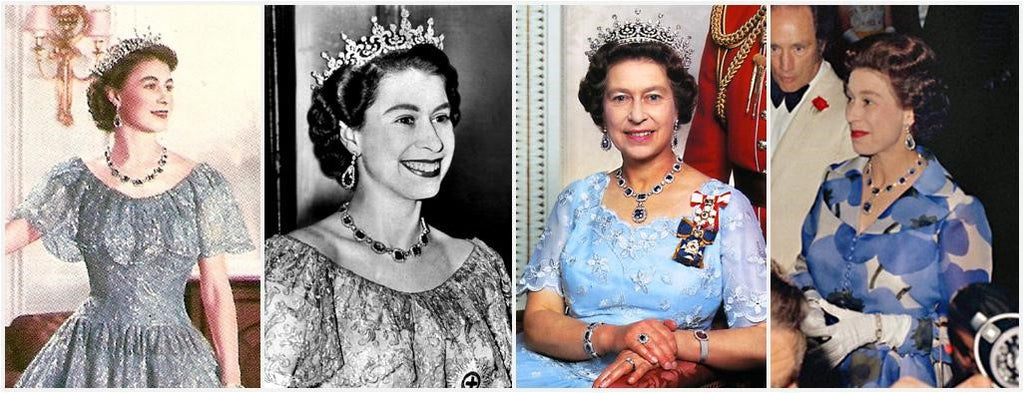
Prince Albert Sapphire Brooch
This brooch is perhaps one of the most cherished pieces of jewelry in Queen Elizabeth II’s Sapphire Jubilee and it features a stunning navy-blue oval sapphire paired with 12 large round diamonds. The brooch was originally given by Prince Albert to Queen Victoria in 1840, the day before their wedding, which she described to be ‘a splendid brooch, a large sapphire set round with diamonds, which is really quite beautiful’. The brooch was earmarked as an heirloom to the crown and was worn regularly by all subsequent queens, Alexandra, Mary, Elizabeth and Elizabeth II. Some of its most famous appearances include the coronation of Queen Alexandra in 1902 and dinner with President and Mrs. Kennedy at Buckingham Palace in 1961.
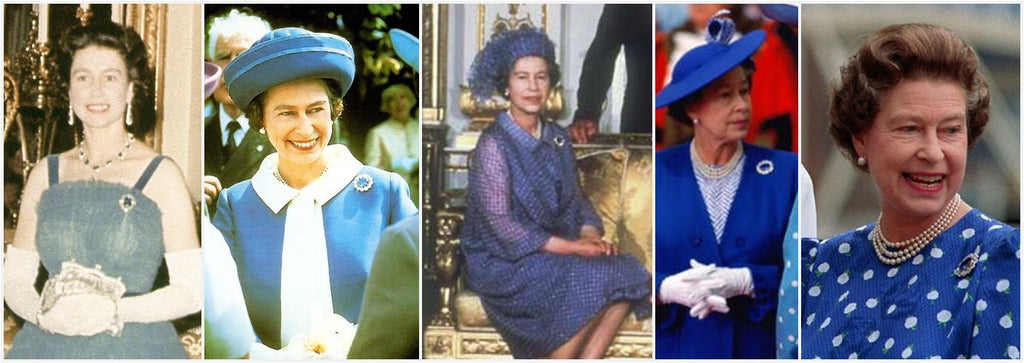
Sapphire Chrysanthemum Brooch
This brooch is one of the first official gifts received by the Queen and its seems to have retained a very special status in her collection. It was gifted by Sir James Laing & Sons Limited and the Anglo-Iranian Oil Company Limited to the then princess- Elizabeth for launching the British Princess oil tanker in 1946. The brooch features a chrysanthemum with diamond petals with a sapphire gemstone center all set in platinum. Some of its most notable appearances have been in the christening of Princess Anne, Queen Elizabeth II’s honeymoon photo and its recreation for her 60th wedding anniversary.
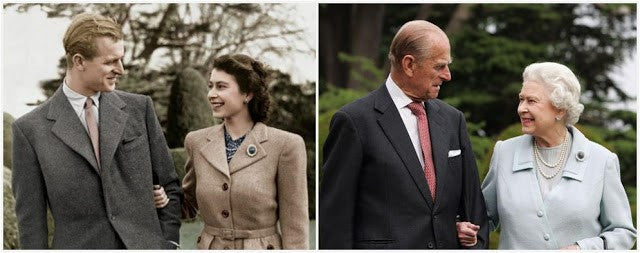
With the invocation of Article 50 and the implications of a hard Brexit looming ahead, a gentle reminder of the power and tenacity of Britain is well founded. Its cultures, strength and elegance will set in a place a poised recovery from its painful separation from the European Union. The Sapphire Jubilee marks 65 years of economic prowess and cultural heritage and we can look forward to plenty more in this new and evolving landscape.
The Hope Diamond April 27 2017
This weekend, I had the privilege of visiting the Smithsonian Museum of Natural History. Entering the dome shaped building near the National Mall was an exhilarating experience as I was excited to see an assortment of wonders from the ancient mummies of Egypt to the weird and wonderful creatures of our planet. However, there was one exhibition that was at the forefront of my mind: The Hope Diamond. I tried my best to enjoy the path leading up to the second floor which housed this glamorous piece, but my impatience and overflowing excitement got the better of me. So, I rushed past all the exhibits and reached the gemological museum to witness the sparkle and glimmer of a diamond with a 300-year-old history from the market, to monarchs and a museum.
The Hope Diamond originated in India, one of the only sources of diamonds in the early 16th century. In 1668 a French merchant by the name of Jean Baptiste Tavernier, acquired this natural gemstone at a weight of approximately 112 carats and sold it to King Louis XIV of France. Early drawings of this magnificent stone depicted that it was cut in an Indian style which emphasized weight over brilliance. In order to achieve the desired aesthetics, King Louis XIV recut the diamond as an addition to the French Crown Jewels, which by 1749 was called the Emblem of the Golden Fleece. To my disappointment, I had learned that by this process, the weight of the diamond has been reduced by over half its original size to a mere 67 carats!
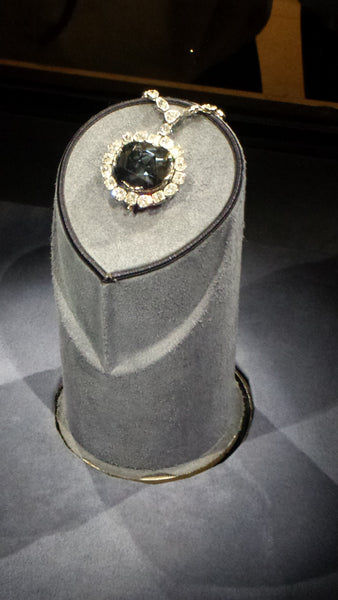 The Hope Diamond reached the shores of America when Evalyn Walsh Mclean bought it from the collections of Pierre Cartier of Paris who is credited with its current shape and design. It has been rumored that Mike, Mrs. Walsh’s great dane, had once modeled the Hope Diamond and was rather playful in hiding the $250 million pendant in the crooks of their living room sofa. Upon the death of Mrs. Walsh, Harry Winston, a prominent jeweler in New York City, bought the Hope Diamond with the intention of giving it to the government as the start of a great jewel collection. As such, in 1958, he donated the Hope Diamond to the Smithsonian Institution and has been marveled by generations since then.
The Hope Diamond reached the shores of America when Evalyn Walsh Mclean bought it from the collections of Pierre Cartier of Paris who is credited with its current shape and design. It has been rumored that Mike, Mrs. Walsh’s great dane, had once modeled the Hope Diamond and was rather playful in hiding the $250 million pendant in the crooks of their living room sofa. Upon the death of Mrs. Walsh, Harry Winston, a prominent jeweler in New York City, bought the Hope Diamond with the intention of giving it to the government as the start of a great jewel collection. As such, in 1958, he donated the Hope Diamond to the Smithsonian Institution and has been marveled by generations since then.
By 1792, the diamond was stolen by a bandit of looters during the week-long French Revolution. Its whereabouts remained unknown for about 20 years until it resurfaced in London a day after the statute of limitations for the prosecution of this theft had expired. A memorandum in 1812 by John Francillion, a London based jeweler, explained that a blue diamond of 44.52 carat was sold to King George IV and was almost certainly the one stolen from the Crown Jewels in France. After the death of King George IV in 1830, the diamond was bought by a London banker by the name of Henry Philip Hope, and from then on, the diamond bore his name. It stayed within his family until 1901 but reached the hands of retailers from across the world as he passed away.
My visit to this museum was incredibly educational and fascinating! It is hard to put into words the magnificence of this piece but I hope that one day that you too will be fortunate to witness the awe-inspiring sparkle of this natural blue diamond.
Legendary Sapphires: The Blue Belle of Asia April 27 2017
The Blue Belle of Asia is one of the world’s most legendary sapphires and it earned the title of the most expensive blue sapphire once it was sold in Christie’s Geneva in November 2014. The initial bid price of 6,650,00 Swiss Francs (approximately $6.9 million) was elevated to the final realized price of 16,965,000 Swiss Francs ($17,564,156) as it was sold to a private collector who remains unidentified to this day.
The Blue Belle of Asia features a 392.52-carat untreated cushion cut sapphire from Ceylon. Its suspended on a brilliant cut diamond tassel pendant and mounted on a diamond and white gold necklace. Gemstones of over 100 carats are often featured in many articles but the quality and size of this sapphire make comparisons very difficult to find. The depths of its captivating deep blue prism are enough to capture any gaze and was highly coveted during the auction filled with enthusiastic private collectors and professional traders mainly from the Middle East.
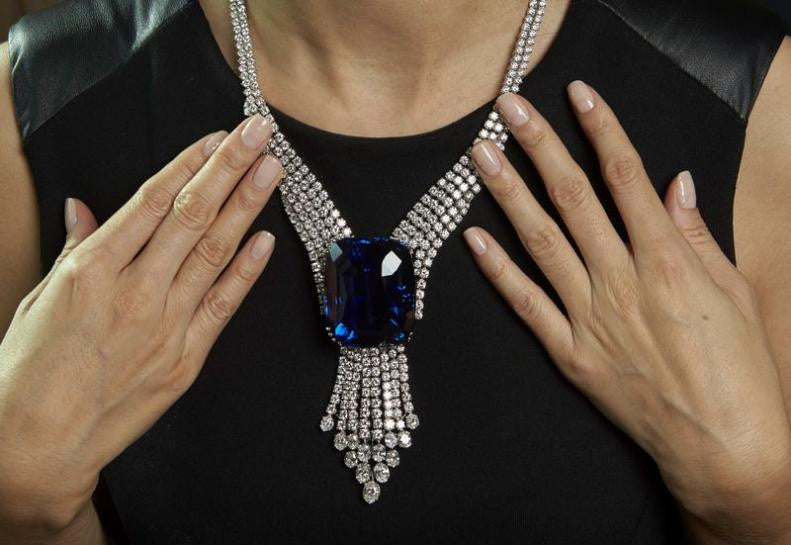
This natural gemstone was first discovered in 1926 in Ratnapura, “The City of Gems” situated in Sri Lanka. It was owned by a well-known gem and jewelry dealer in Colombo by the name of Macan Markar who established the famous firm, O.L.M. Macan Markar in 1860. With clientele ranging from members of the British Royal family such as HM King George V, Markar described this gemstones as one of his most cherished as it possessed the ‘highly prized peacock blue color and excellent clarity’. After its original cut and polish, the Blue Belle of Asia held approximately 400 carats and was sold to the Lord Nuffield, the founder of Morris Motors Limited in 1937.
The reasons behind the purchase of the Blue Belle of Asia by Lord Nuffield were quite mysterious. The reported intent was to present it to HM Queen Elizabeth during her coronation on the 12th of May in 1937 but it subsequently ‘disappeared’ into private hands for the next 35 years. It had been reported to be examined by the Swiss-based gem dealer, Theodore Horovitz in the 1970s but it continued to change hands behind closed curtains and reappeared for sale under a large estate collection of a Saudi collector in 2014.
Sapphire to the extent of this size, color and clarity are incredibly rare and rank as one of the most prestigious gemstones to ever become available in the market. Rahul Kadakia, the International Head of Christie’s Jewelry Department, stated that they are ‘extremely proud that the Blue Belle of Asia established a new world record for any sapphire sold at an auction’ and added that ‘the private collector, seated in this room, is now the new owner of the most valuable sapphire in the world’ without identifying the buyer. The beauty and mystery surrounding this sapphire is captivating and we are patiently awaiting its next reappearance in the public eye.
Got Diamonds? February 09 2017
The history of natural diamonds dates back billions of years into the pre-historic era of our planet Earth. This incredible gemstone was forged under tremendous temperatures reaching almost 2400 degrees Fahrenheit and a pulverizing pressure of almost 800,000 pounds per square inch (almost 12,000 times the pressure found in the tires of an automobile). Under these conditions, the energy and compactness brings everything closer together. To bring back a well forgotten chemistry lesson, these parameters enable carbon atoms to bond together in a lattice structure through very strong covalent bonds. As a result, diamonds are created as one of the hardest structures known to man with a rating of 10 in the Mohs scale.
With the presence of convection currents in the mantle of the Earth, these newly formed diamonds slowly make their way up to the crust and are spewed out through explosive volcanic eruptions. Once brought to the surface, they are contained within the cooled volcanic material surrounding it; these are the so-called kimberlites that typically source many of the diamonds across the world. Prior to the 18th century, diamonds were largely mined from India but they were quickly overshadowed in the ensuing years of the late 1800s by the Great Diamond Rush in Africa. Today, approximately 30% of the diamonds that are mined worldwide are of gem-quality and the US accounts for over 40% of its global demand – making it the world’s largest diamond market.
One of the most famous diamonds to be discovered is the historic Cullinan Diamond, found in 1905 in South Africa. Weighing in at 3106 carats, the Cullinan Diamond was cut into a total of 105 diamonds of flawless color and clarity. The two largest stones are a part of the British crown jewels as the Great Star of Africa (530.2 carats) and the Lesser Star of Africa (317.4 carats) and the remaining diamonds cut from the Cullinan are hosted in private collections. The word carat, used to measure the weight of diamonds, originated from the Greek word ‘keration’ meaning the carob tree whose seed was used for centuries as the standard for weighing precious stones. A carat became a standard metric for diamonds in 1913 with 1 carat equivalent to 0.2 grams or 0.007 ounces.
Another famous diamond is the Wittelsbach-Graff which is the largest blue diamond standing at a weight of 31.06 carats. Natural blue diamonds, being extremely rare, exist due to the presence of minute boron impurities within its carbon lattice structure. Graded as a diamond with a fancy deep blue hue and an internally flawless clarity, the Wittelsbach-Graff was sold at Christie’s London for just over $24.3 million. There is an incredible wealth of history and knowledge surrounding diamonds and its glamorous and breathtaking nature continues to impress admirers from across the world.
The Padparadscha Sapphire January 16 2017
When it comes to gemstones, the padparadscha (pronounced as pad-pah-raj-ah) sapphire, provides the perfect combination of lustrous color and rich symbolism to craft a jewelry masterpiece. Primarily found in the lush green foothills and river basins of Sri Lanka, the padparadscha has reserved a special place in the hearts of many across the world for its rarity and breathtaking beauty. Its popularity has risen in the recent past as a centerpiece for engagement rings based on its distinctive hue and cultural symbolism.
The extreme rarity of padparadscha sapphires is one of its discerning qualities. As such, its cut is designed to preserve as much of the gemstone as possible. This gives rise to many unique shapes but the predominant cut for a natural padparadscha is either the oval or cushion cut. In terms of size, fine natural padparadscha sapphires above two carats are deemed to be very rare and anything above five carats is often considered a world-class piece. When choosing a padparadscha as the main gemstone for a ring, perfecting the ring setting and the choice of metal is crucial to highlight its natural beauty. Padparadschas are often very warm in color and hence choosing a diamond halo or a paved setting is highly recommended. With regard to the type of metal, a pinker padparadscha often suits a yellow gold metal and a more orange hued gemstone is best paired with rose gold. If found within this spectrum, a white gold metal helps to illuminate the gemstone once worn.
Exhibiting a delicate pinkish orange hue, the padparadscha, mimics the aura of a stunning sunset that blends its light across a canvas of clouds. The name, padparadscha, originates from the Sinhalese word for the lotus blossom, a water lily that also features this precious pink color. The story of this unique gemstone goes beyond the color it exudes: A lotus blossom grows from the bottom of a muddy and murky pool and emerges from the water every morning as a beautiful flower that is completely unstained. For the Buddhists of Sri Lanka it represents the divinity of enlightenment as well as the themes of purity, fertility and eternity. For us it represents a form of strength and boldness to ascend and face the challenges we experience in our daily lives and blossom in overcoming them. For many, the padparadscha comingles all of the qualities that serve to create a beautiful relationship and hence makes it ideal as an engagement piece.
You can visit our online store here to view our collection of natural padparadscha sapphires. Feel free to contact us at elizabethjewellers@gmail.com for any advice or information in designing your very own padparadscha jewelry.
Gem Cuts November 15 2016
The defining characteristic of a gemstone can often be its cut. Round, oval, cabochon, cushion, heart and radiant are all popular cuts used in an assortment of gems and each tells a special and unique story. Transforming rough and unpolished gems into the shapes we know takes several years of experience and an eye for immaculate detail. Professional gem cutters who have perfected this art and skill can reveal the true color and brilliance of a gemstone and showcase its innate beauty. In this blog, we’ll dig a little deeper into the countless cuts available for gems from across the world.
The cabochon cut is by far the oldest known cut to be used on a gemstone. Simply put, it is a polished gemstone without any facets. With a flat bottom and a rounded top, this traditional cut can be used on any shape and hence was the prevalent choice since the early 13th century when the expertise and knowledge of modern cutting were still being developed. Even with the advancement of cutting technology, some stones exhibit their unique character only if they are cradled under a cabochon cut. For example, asterism, or the star effect in sapphires and chatoyancy, the cats-eye effect in tourmaline is best viewed under a cabochon cut. The smooth viewing angle not only helps to minimize any scratches but also disperses light in a way that preserves these natural phenomena.
One of the most difficult cuts to be made is the briolette. Shaped as a drop, it consists of 84 symmetrical triangular facets surrounding its body with no table, crown or pavilion. This intricate cut does not help the gem emanate a bursting brilliance but its orientation aids the reflection of light from all angles. The many angles, like tiny chandeliers, lead to a wonderful display of radiance and shimmer and hence is popular for dangling earrings. Most jewelers mount briolette cuts using a precious metal cap secured at the tip of the gem or may simply drill a hole through its tip and insert a hanging metal wire. It is believed that the briolette cut originated in India during the 12th century and was later introduced to the rest of the world through the excursions of the French traveler, Jean-Baptiste Tavernier. Its popularity rose in western Europe as it was featured in a large array of tiaras, crowns and earrings used by monarchs especially during the Victorian and Edwardian time periods.
Another popular cut is the trilliant. The curved variation of this triangular shape is known as the trillion and is usually used for single solitaire stones whereas its un-curved counterpart, the trilliant, is better used for side stones. Consisting of 31 to 43 facets, this symmetrical cut can exude a brilliance second to none as its carefully engineered proportions reflect and align light to the eye of its beholder. Due to the shallow nature of this cut, the transparency of the gem is slightly enhanced and can make dust and dirt on its surface appear more readily. Although this cut may require some extra cleaning, its upside is that the shallow cut enables the gem to appear bigger given its weight. This illusory nature makes it popular for minimizing waste during the cutting process.
The cabochon, briolette and trilliant have unique features that highlight different aspects of a gem. These three cuts are just a peek into the wide spectrum of cuts developed over time within the gem industry. The radiant silhouettes they encompass have been perfected over hundreds of years and the artistry and skill will continue to produce more magnificent ways of sparkling in your eyes.
The Origins of Gems October 24 2016
Geo-tagging on Facebook and Instagram is a simple concept we can all understand. Take a picture overlooking the arches of the Eiffel Tower or the golden sand dunes of Riyadh and use the GPS on your phone to share exactly where you were at that moment to your friends and family. But, how does one determine where a sapphire comes from? Most gem certificates accompanying natural gemstones authenticate the country of origin so what does it take to know where exactly a piece of Mother Nature was created?
At its elemental level, sapphires are composed of about six tenths in Aluminum and the rest in Oxygen. However, as is with many fine chefs, each batch is given a unique spin by Mother Nature and sapphire deposits from around the world contain varying levels of other ingredients such as iron, titanium and other minerals. Some gems wear their heritage openly but other require careful examination – so in order to determine their origin, gemologists look at an assortment of characteristics such as the inclusions within the stone, optical nuances and chemical composition. Ideally, these characteristics should not only point toward a particular origin but also exclude other possibilities.
A common method used to identify Kashmir sapphires is through its inclusions. Embedded within its deep velvet blue are certain pargasite and tourmaline crystals which are not found in sapphires anywhere else in the world. Similarly, uranpyrochlore inclusions are often seen in sapphires originating from Cambodia or southern Vietnam but not from locations in Burma or Kashmir. In this respect, the existence of specific inclusions can serve as a positive indicator of its true origin. In addition, certain optical nuances have also been used to differentiate sapphires that come from Kashmir. For example, the velvety blue ‘silk’ of Kashmir sapphires comes from particles that are suspended within the crystal structure that scatter and disperse light as it passes through. This low fluorescence is in direct contrast to many sapphires found in Sri Lanka which emanate a brighter and crisper tone of blue. However, these comparisons are not always clear cut. A set of complete data from gem localities from around the world has not yet been compiled to confirm local characteristics and so its identification still remains as a form of art and experiential judgement.
This is of course where science and technology steps in to wipe away the mist of uncertainty. Spectrophotometry has been a prevalent and preferred method in many laboratories to ascertain the origin of gems. The equipment enables the gemologist to separate the light that passes through a sapphire into different wavelengths characteristic of its elemental make-up. The spectrum of wavelengths indicates the proportions of a sapphire’s trace elements and these results can be used to correspond whether it of the same geographic region as a known sample of gemstones. This technique has been very successful in differentiating between sapphire ‘look-a-likes’ such as the Kashmir sapphire and the Cambodian sapphire. The key difference precipitates to a stark contrast in the concentration of iron present in gems found in these localities. Such techniques have worked wonders in building trust among traders and have compounded the growth in reliable international trade.
Despite these advancements, many improvements are still warranted. The existence of representative samples and complete data sets from around the world have hindered many identification processes but strides toward progress are made every day. The veil of ambiguity and lack of complete certainty have led to certain organizations such as the Gemological Institute of America (GIA) to abandon the issuance of origin certifications. However, the industry is constantly developing and we expect more synergies between the art and science of determining gem origins to enhance the overall level of accuracy and reliability.
The Gold Eureka October 09 2016
Eureka! Eureka! The story of Archimedes jumping out of his bath tub in revelation of a profound solution has been with us for centuries. The legend highlights the Greek scientist’s response to the gold testing problem: to determine, without damaging, whether the new crown of King Heroin II of Syracuse is of fine gold or a suspected adulterated alloy. His solution, of course, was the principle of density which we vaguely remember from one of our earlier physics classes. In essence, the amount of water displaced from a tub of water when the crown is immersed in it should be equal to that displaced by a similar object of known gold purity. The tests for gold purity has advanced by leaps and bounds since this early ‘hydrostatic density’ measurement but this story puts forward an important requirement of the gold industry – a test that is rapid, simple, consistent, relatively inexpensive & non-destructive.
One of the earliest institutions responsible for ascertaining the purity of gold and hence protecting consumers is the Worshipful Company of Goldsmiths in London. From the Kings of early 1300s to the bustling economy of today, the United Kingdom among many other nations, require all items of gold sold to be sent to assigned assay offices for ‘hallmarking’ – an authentication process by which the gold may be certified through four or five marks indicating the sponsors mark, the finesse in parts per thousands and the year of marking. Although some nations may show slight differences, the standard policy is to have a zero negative tolerance for a stated purity. For example, a 749 part per thousand gold cannot be marked as 18 karat gold which is standardized at 750 parts per thousand. At present, international standards put forward by the “International Convention on the Control of Marking Articles of Precious Metals” guide the standard karat weight and enable countries to accept gold from other nations which have been tested by authorized laboratories without further verification.
Gold Assay reports employ a variety of techniques to determine the purity of gold. In addition to the hydrostatic density technique, fire assay is another one of the earliest form of gold testing. It involved oxidizing the metal at a high temperature in an attempt to separate the base and noble metals. Residual metals are dissolved away using nitric acid and the weight of the remaining fine gold is compared to the weight of the original sample. These methods, rudimentary at best, served well during the early ages of the jewelry industry but with enhanced technology, stricter demands for quality and an increased competitive landscape they were quickly replaced by tests offering higher reliability and accuracy.
One of these newer techniques includes a form of spectroscopy called directly coupled plasma (DCP). An improvement upon its predecessor, atomic absorption, DCP places a sample of the gold in a liquid solution and excites it using a high temperature plasma. The excitation releases light at certain wavelengths which can be measured based on the signature characteristics of elements present in the sample. This method vastly improves the achieved accuracy to an order of 1 part per million but is compromised in its ability to process large batches in an automated fashion. Hence, the cost of using this advanced method has become a large hindrance for its implementation in laboratories across the world. Another advanced test involves x-ray fluorescence which came in to play in the 1960s with the rapid development of computer technology. In this method, a sample of the tested material is struck with an x-ray and the resulting secondary x-ray emitted is collected and scrutinized for the composition and proportion of elements present. Once calibrated to comparable standards and synchronized using powerful data aggregators, this method produces results with much greater accuracy that DCP spectroscopy. Once again though, issues related to the short wavelength of x-rays and the need for internal homogeneity of the metal, surface sensitivity affecting valid data collection and the costs related to purchasing and training personnel to use this machinery makes it an incredible challenge to implement industry-wide.
With advances in technology come better expertise and falling costs and these are significant factors that contribute to improving the metallurgical assay tests used by the jewelry industry. As is with most of life, the key here is to strike a balance so that the tests are not only reliable and accurate but also cost effective to utilize in large volumes of samples. A eureka moment may not be available to enhance the testing methods overnight but improvements are made gradually and surely to foster an environment of increased trust between retailer and client.
The Joys of Color October 02 2016
Color can often be the hallmark of a stunning gemstone. The Gemological Institute of America (GIA) and many jewelers across the world use a host of terms to describe these colors and a quick glance at them can often precipitate a state confusion. ‘Violetish blue/vB’, ‘Vivid’ and ‘Medium Dark’ are all terms that can be used to describe the color of a fine sapphire but what exactly do they mean? Informed purchases are often the best purchases and therefore a little knowledge on color would place you on a path to selecting the right gemstone at the right color.
A trip down memory lane to one of your art classes may shed light on what components constitute color. If you remembered that they were hue, saturation and tone, I’d say I’m quite impressed, well done! The three attributes are highly integrated and play a delicate role in producing colors across a wide spectrum from the faintest yellows to the darkest blues. When assessing the color of a gemstone, keeping these factors in mind can help you determine not only the make-up of it color but also why the jeweler may have proportioned the gem as it appears.
Hue generally refers to the initial impression of the gemstone’s basic color. The hue is best assessed ‘face-up’ with the table of the gemstone being perpendicular to your eyes. This can be done under white light or even a natural ambience and is often described as yellow, blue, green, red or orange. As mentioned earlier, some hue descriptions may state ‘violetish blue/vB’ or ‘reddish orange/rO’. This is usually as a result of a color combination being emitted from the stone perhaps through a phenomenon known as ‘color zoning’. Gemstones with a pure hue which are undisturbed by any others are generally regarded as more valuable than those with a mix of hues. For example, blue sapphires are generally preferred as pure blues or ‘violetish blues’ as opposed to green secondary hues.
Tone is the second dimension of the world of colors. From a visual perspective, it runs from white to black with a fine gradation in between these two extremes. In terms of the tone scale issued by the GIA, gemstones can be found to be very light (2), medium (5) or very dark (8). It is important to note that is a separate attribute when determining color but it is deeply intertwined with hue and saturation such that a gemstone may have a light tone but the interaction between hue and saturation may make it exude a darker tone. In terms of sapphires, the finest range from medium light to medium dark as is characteristic of many famous Ceylon sapphires such as the Logan sapphire. You can also view our featured sapphire bracelet showcasing a stunning display of tone here.
The final character is built on saturation. This refers to intensity or strength of color presented by a gemstone. The GIA has issued a scale for saturation as well and it runs from (1) to (6). Warm (reds and yellows) and cool (blues) colors have similar descriptions in the scale from (4) to (6) ranging from ‘moderately strong’ to ‘vivid’. However, as saturation weakens for warmer colors they appear as brownish (1) or as grayish (2) for cooler colors. The finest sapphires, of course, will generate a saturation from (4) to (6) with vivid being the most desired. This two tier scale helps to add a standard across the global gem industry and ensures like for like comparisons whether you’re in Colombo or New York.
A color description as ‘vB5/6’ for a gemstone should then a little easier to decipher. It refers to a gemstone possessing a violet blue hue with a medium tone and a vivid saturation. The standardization of color removes personal and geographical biases that may come across descriptions such as ‘sky blue’ or ‘ocean blue’ and make the purchase of a gemstone much more objective and hence enjoyable. Now, color can remain a day-long obsession and joy and less of a torment!
Gem Policies: A Grinding Growth September 18 2016
Politics, policies and pundits have once again reached national headlines to decide the future of the Sri Lankan Sapphire. In an island that has broken free from the chains of a civil war and is now poised for exponential and almost explosive growth, the ascent to development and prosperity can be turbulent at best. One such cross wind lies in how the nation reacts to the surge of foreign direct investment and capitalizes the opportunity to jump start the engine of economic growth without destroying what makes it beautiful.
In a report that has been filed to the President of Sri Lanka, the National Gem & Jewellery Authority has asserted that local companies should be prohibited from forming joint ventures with foreign gem mining companies. This view has been supported by the regional ambassador of the International Colored Gemstones Association, among many others, and appears to be heading its way to consolidating the current protectionist stance adopted for the gem industry.
The report highlights concerns arising from a variety of market indicators depicting rising FDI inflows into the Sri Lankan gem market. For example, local firms acting as the hand of their foreign counterparts, have purchased over 100 acres of prime gem-rich lands in areas covering the Ratnapura district and a Singapore based auction has announced that it will include sales of unpolished Sri Lankan origin sapphires for the first time in early 2017. So, what’s the cause for concern?
The first risk lies in the impact on the environment and local habitats. Traditional gem mining, adopted and sustained by local miners, have remained as distinct, small scale operations throughout the past and have consistently recorded low environmental damage. These miners are strictly regulated by national green mining standards and are limited in number as a result of the control in licenses issued. The issue with having large scale investment in mechanical mining operations needs no introduction after what the world witnessed during the ‘Mozambique Ruby’ operation. Further, there is an incentive to avoid large scale destruction of the land and natural habitats as it is crucial to the tourism sector of Sri Lanka. The gem and tourism industries directly employ over a million Sri Lankans and any disruption to that employment base is likely to be a major concern for the policies put in place by the government. The spillover effects of environmental destruction to the ability of local enterprises to attract tourists from around the world is yet another reason why local activists have resisted the growing FDI inflows to the gem mining sector.
The impact on prices for natural gemstones as a result of higher investment adds another layer of complexity. Foreign interests in large scale mining operations within Sri Lanka have the ability to flood the market with an abundance of sapphires, rubies, topaz, garnets and more. The resulting blemish on the rarity of these natural gemstones can cause prices to plummet and have disastrous impacts on the livelihoods of those employed by the gem industry. Over 600,000 Sri Lankans working as lapidarists, miners, retailers, and wholesalers would have to face a dramatic decline in their state of well-being if their income is slashed by a blunder in industrial economic policies. This proposal for an ‘artificial’ floor in prices for natural gemstones lower the benefits to consumers but it has to be finely managed in order to avoid potential negative externalities arising through large scale environmental destruction, blemishes to the rarity factor of Sri Lanka’s natural gemstones and a potential for a decline in living standards for those employed by this industry.
Controls in price exist not only in the gem industry of Sri Lanka but also in oil producing OPEC nations and in the diamonds supplied by De Beers. Navigating this landscape requires a careful assessment of many stakeholders including the local miner earning a living wage, the general community exposed to the state of the environment and the retail price paid by the customer. It appears that we have reached a situation of Nash equilibrium where one party can’t be advantaged without hurting the other but the policy to be decided will nevertheless keep the engine running.
A Cutting Lesson September 10 2016
Sri Lanka is the mecca of the world’s finest natural gemstones. This island is blessed with the planet’s richest gem deposits as a result of an abundance of high-grade metamorphic rocks formed from the mineral belt that separated Rodinia, the super continent that preceded Pangaea. Throughout its rich history, Sri Lanka has gained a reputation from travelers from the far edges of the globe of its stunning collection of glittering gems. Marco Polo noted the abundance of sapphires, rubies and garnets during his exploration of the island in 1293, Pliny the Elder wrote of his encounters with fine gemstones from Taprobane, one of Sri Lanka’s former names, in 41 AD and the Mahavamsa (a chronicle detailing Sri Lanka’s earliest recorded history) describes the gem encrusted throne of a Naga King in 543 BC. Despite this blessing, Sri Lanka has not always been wise about the best use of these natural gemstones. One such blemish in its history relates to the process of gem cutting.
A cutter’s primary goal is to maximize the value of a gemstone given a rough. More often than not, this involves compromising in proportions to save weight and avoid any loss of money whilst retaining international standards for symmetry. However, with limited access to global markets, especially in the early 1900’s, and a host of government controls that restricted the sale of roughs, the best prices available for Sri Lankan origin gemstones were often capped. As a result, local dealers and cutters resorted to a native cut in which symmetry and proportions were marginalized and the orientation of the gemstone within the rough was prioritized. It was more profitable to export native cut parcels of gemstones, recut them abroad to the standards required by the international market, and resell them for a higher margin.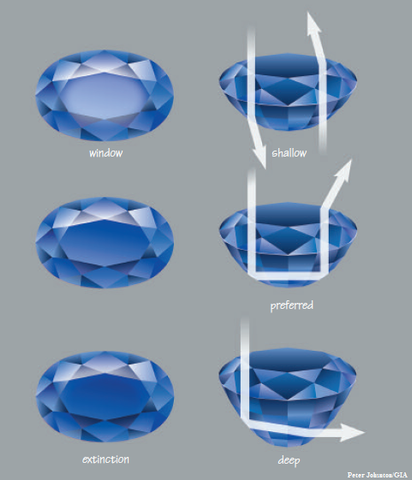 So why are symmetry and proportions so important? Let’s find out! In the case of a gem where its pavilion is cut too shallow, there is a significant risk that it may develop a window that desaturates it color. In essence, the light entering through the crown of the stone, reaches the facet of the pavilion and is not reflected back in to the eye. And, because the pavilion is shallow, light from below travels through the pavilion and reaches the eye as well. As a result, the gem develops a ‘window’ in which its optimal color is less intense than if it had been cut to the correct proportions. In the case of a gem where its pavilion is cut too deep, there is a significant risk that an extinction develops where unattractive dark areas spoil the hue of the gem. Just like in a shallow cut pavilion, a deep cut pavilion does not reflect light back in to the eye once it reaches the pavilion facets. Instead, the light ‘leaks’ away from the gem due to the compromise in gem proportions. In either case, light leakages, either planned or not, have considerable impacts on the value of the gem.
So why are symmetry and proportions so important? Let’s find out! In the case of a gem where its pavilion is cut too shallow, there is a significant risk that it may develop a window that desaturates it color. In essence, the light entering through the crown of the stone, reaches the facet of the pavilion and is not reflected back in to the eye. And, because the pavilion is shallow, light from below travels through the pavilion and reaches the eye as well. As a result, the gem develops a ‘window’ in which its optimal color is less intense than if it had been cut to the correct proportions. In the case of a gem where its pavilion is cut too deep, there is a significant risk that an extinction develops where unattractive dark areas spoil the hue of the gem. Just like in a shallow cut pavilion, a deep cut pavilion does not reflect light back in to the eye once it reaches the pavilion facets. Instead, the light ‘leaks’ away from the gem due to the compromise in gem proportions. In either case, light leakages, either planned or not, have considerable impacts on the value of the gem.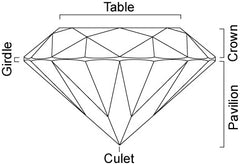 Several decades of this situation has meant that Sri Lanka lagged behind many markets in its development of technology and investment in precision cutting. It was simply more profitable to have the perfect cut after it leaves the sandy shores of paradise. However, as global trade became more integrated and international payments flourished, the possibilities of commanding higher premiums from within the borders of Sri Lanka improved. Instead of setting up branches abroad and incurring expensive cross border costs, local dealers began to invest in enhancing the local cutting process from the wealth of expertise they gathered from the international community.
Several decades of this situation has meant that Sri Lanka lagged behind many markets in its development of technology and investment in precision cutting. It was simply more profitable to have the perfect cut after it leaves the sandy shores of paradise. However, as global trade became more integrated and international payments flourished, the possibilities of commanding higher premiums from within the borders of Sri Lanka improved. Instead of setting up branches abroad and incurring expensive cross border costs, local dealers began to invest in enhancing the local cutting process from the wealth of expertise they gathered from the international community.
As a result, Sri Lanka has had the opportunity to learn from the mistakes of the pioneers in the cutting field and implement an industry that embraces best practices from across the world. Today, precision cutting standards in Sri Lanka are second to none and many gemstones that were sold in the bygone era of native cuts and are now reentering the global market are being recut to meet the new gold standard of symmetry.
Being blessed with natural resources does not grant the right of complacency. Sri Lanka has definitely learned that lesson. Perhaps, it serves as a lesson for all of us as well. Natural talents or attributes shouldn’t be taken for granted. Building upon them and continuously improving cements our position as leaders but the cracks won’t stop appearing. It is our responsibility to be aware of them and close them up as quickly and effectively as possible.
The Reality Of Sapphire Treatments September 04 2016
Clients from across the world who seek to purchase natural sapphire gemstones from their jewelers seem to always prefer unheated sapphires. However, this rare precious gemstone is even more so when it comes to unheated sapphires. The stark reality of its extreme rarity severely limits the color, size and shape available for clients and hence almost all purchases are made with heat-treated sapphires. In fact, gemstone treatments have been the norm for several centuries with the earliest record found in Pliny the Elder’s Natural History written in approximately 77 AD.
While there is an assortment of gemstone treatments, heat is by far the most common and most preferred method. The fundamental goal of heat treatment is to dissolve rutile inclusions within the crystalline lattice structure of the gemstone. Rutile refers to minerals composed of primarily Titanium Dioxide which act as minor blemishes of a natural gemstone such as a sapphire. Heating the sapphire to a temperature between 1,700 degrees centigrade and 1,843 degrees centigrade, the melting point of rutile, achieves two desirable consequences; the sapphire experiences an improvement to its clarity through the removal of any ‘cloudiness’ and its color is enhanced as the rutile decomposes to its structural elements and releases titanium into the lattice structure. These treatments are often reliably tested by laboratories and Gem & Jewelry Authorities and are meticulously certified before being sold.
Like inclusions, color zoning is usually regarded as a less than desirable trait for sapphire gemstones. A fine sapphire attributes itself a uniform and consistent distribution of color and a break in that smooth gradation results in a significant loss in value. Color zoning originates through the concentration of color generating trace elements during the formation of the crystal over several thousands of years. Despite being a factor for discounting value for sapphires, color zoning can often be a valuable trait for other gemstones such as amethyst or citrine. In the case of citrine, the orange hue can form through an elaborate blend of yellow and red color zoning. The natural phenomenon of color zoning can also be used to test the authenticity of these gemstones as synthetic gems are often engineered to an even color dispersion.
While some imperfections such as inclusions materially deteriorate the value of a gemstone, others such as color zoning can contribute vastly to generating value. Treatment methods such as heat are the reality of many precious gemstones such as sapphires and are incredibly important to delivering a product of nature that is minimally shaped by man but maximizes the value given to clients.
Real is Rare July 16 2016
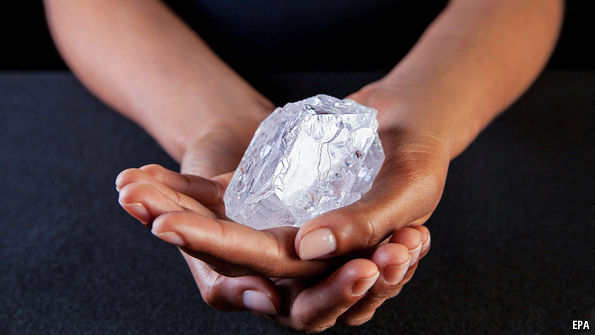
The Lesedi La Rona, a stunning diamond we featured in one of our earlier blogs, has had an epic journey. Forged by the brute forces of Nature almost 2.5 billion years ago, it had risen through the chasms of inner Earth and lay hidden on the surface for millennia. As humans evolved, as empires and nations formed and crumbled, as the world’s technology developed, the Lesedi La Rona stood patiently awaiting its discovery. The grand scale of time and power witnessed by diamonds grant them a unique mystique but not even that could avoid the paltry result of its auction held last week at Sotheby’s.
The 1,109-carat Lesedi La Rona failed to even make the $70 million reserve as a wave of disappointment spread across the auction floor in London. The diamond industry had little to celebrate but attributed a key set of factors contributing to the meager bidding levels for a diamond placed at the same league as the 3,107-carat Cullinan Diamond found in 1905; The rapidly developing technological landscape, the socially aware consumer and the wake of an evolving financial industry.
New technology has paved the way to the creation of synthetic diamonds that are becoming increasingly widespread in its use. They are usually formed in laboratories utilizing large mechanical presses that simulate the incredibly heavy pressures and high temperatures found deep underground, or a process known as chemical vapor deposition that literally grow diamonds one carbon atom at a time. As the development of this technology improves and the high costs of R&D gradually decline, these synthetic diamonds will begin to become competitive in the jewelry market just as it has dominated the market for industrial use.
The use of this new technology feeds into the second factor contributing to the hesitance experienced by more auctions across the world. Man-made diamonds simply eliminate the prospect of having to worry about whether the diamond a consumer has purchased is being used to finance warfare and other humanitarian crises. True, the 2003 Kimberly Process Certification scheme helped screen out a large portion of these illicit trades, but the intricacies of the system have allowed regulators to focus much of their attention only to diamonds funding rebel armies. Consumer awareness, buttressed by Hollywood glamor and the likes of Leonardo DiCaprio in ‘Blood Diamond’, make it much more hassle free for consumers to choose diamonds from a lab than to risk the off chance of purchasing a mined diamond from conflict areas. The sales of synthetic diamonds are still miniscule compared to the $14 billion of rough diamonds sold each year, but it represents an interesting and noteworthy trend.
The third factor relates to new regulations implemented within the global financial industry at the close of the financial crisis in 2009. Enhanced transparency and tighter credit standards have made lenders such as Standard Chartered, an emerging markets bank, to cut their $2 billion exposure to the diamond financing segment. Stricter trading terms have indeed lowered the tolerance for risk and many players within the industry are adjusting to the new norm by scaling back their purchases.
The resonance of ‘A Diamond is Forever’ appears to be fading but as is with change, market innovators are emerging. They appear to stand behind the call of ‘Real is Rare’ to appeal to millennials who show a marked inclination for authenticity. A dash for origin certifications is compounding within the industry as they try to keep their sparkle and we expect this age old trade to experience many changes to meet the needs of the contemporaneous consumer. The Lesedi La Rona may not have met its expectations last week, but it surely lit the path to a new era within the diamond industry.
Jewelry You Can Wear All Day! June 21 2016
When it comes to jewelry, one aspect is often overlooked. You’ve considered the price, the hue, the elegance and everything that comes to mind but its everyday practicality is often shadowed by the high of emotions you experience during your purchase. How will this ring feel on my hand under the heat of the summer sun? Will this bracelet become a heavy weight as the day progresses? Are these earrings made of material sensitive to my skin? These questions are often vital to ensure your desired jewelry ‘feel’ as elegant as they look.
At Elizabeth Jewellers, we pay close attention to the material we select for all our jewelry. Our white gold collections are delicately alloyed with a ‘Noble Metal’ known as Palladium. This highly inert element is revered for its hypoallergenic character and it pushes the envelope in avoiding allergic skin reactions as opposed to traditional alloys consisting of nickel or zinc. This wonder metal is also much lighter and tougher than traditional alloys and allows our jewelry to remain light and lustrous today and every day. Ensuring that the we’ve made the right choice of materials for our jewelry is paramount to ensuring client satisfaction, so we dedicate a large portion of our time and efforts in understanding the needs of our clients.
Our featured ring in this blog, is yet another beautiful natural sapphire ring. As expected, its band consists of 18K white gold that is light, hypoallergenic and lustrous so that it can be worn all day to complement your style and smile. Its unique prong setting highlights a lush yellow sapphire from the heart of Sri Lanka that emanates a vivid color both in and out of the sun. At Elizabeth Jewellers, we pride ourselves in making high quality, genuine jewelry. Each purchase is accompanied by a Jewelers Certificate that authenticates the nature of the precious gemstone and upon request, it can be independently verified by an institution of your choice, including the Gemological Institute of America (GIA).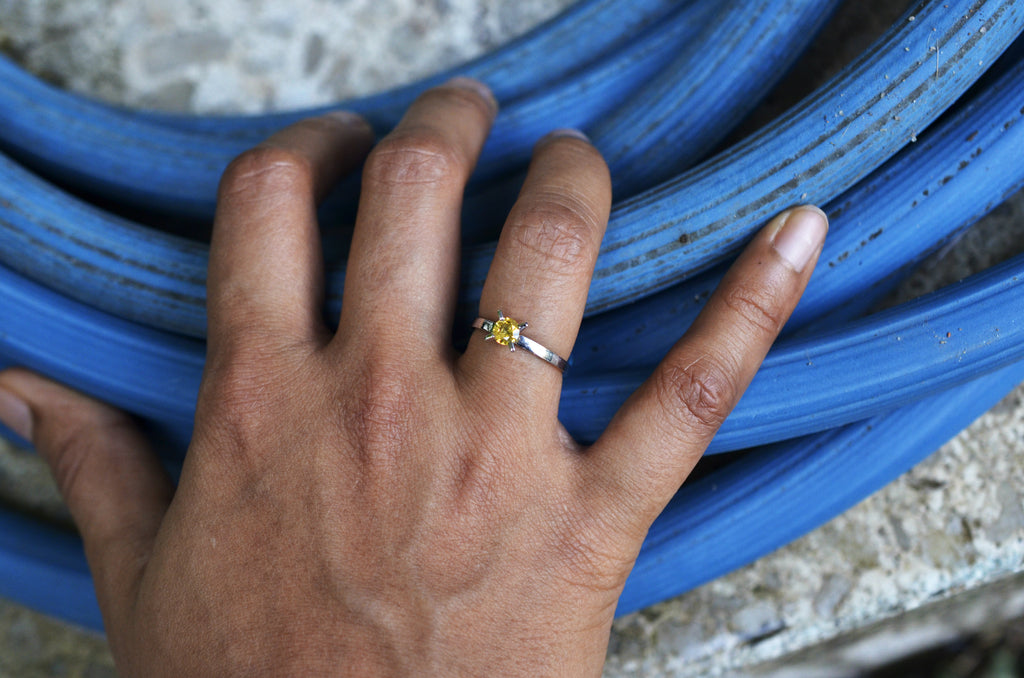
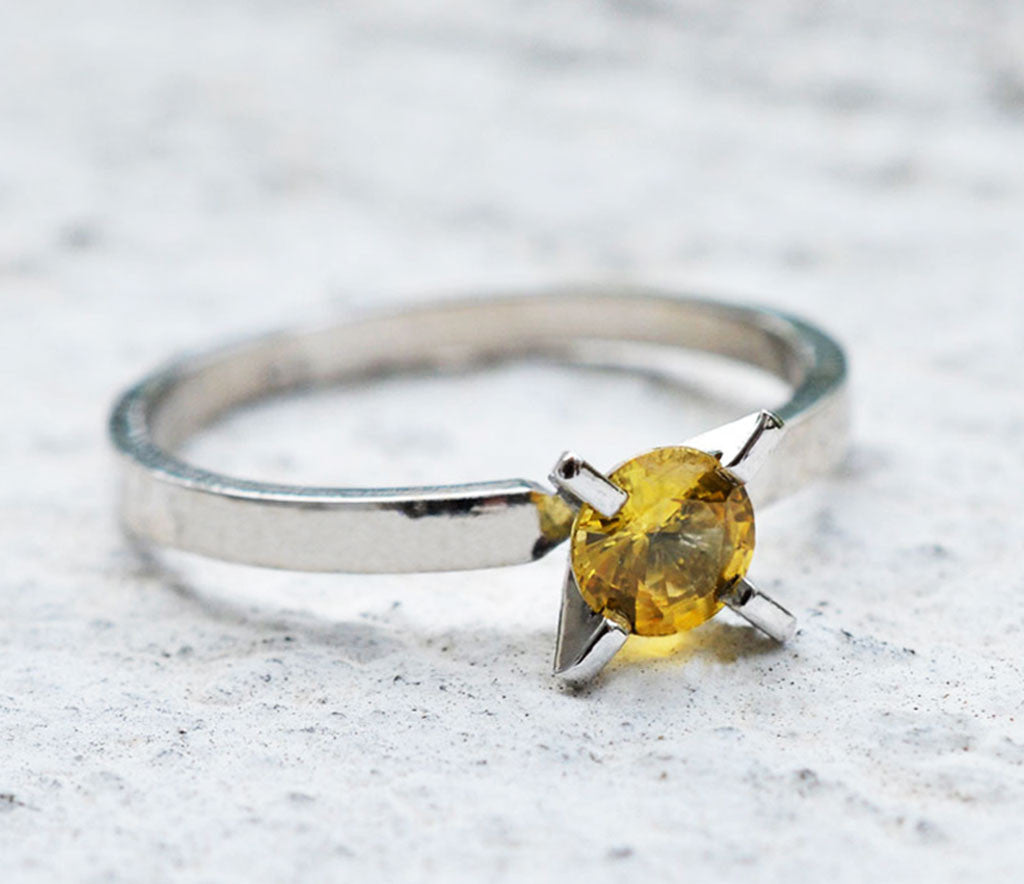
Our team is passionately following client preferences and understanding what it takes to be a better jeweler. We are always learning so that we can provide nothing but the best for our clients. If you have any questions at all, please feel free to contact us at directly at elizabethjewellers@gmail.com.
The President's House & Sapphires To Match! June 11 2016
For the first time in Sri Lankan history, President Maithripala Sirisena has decided to open the colonial-era President’s House to the public eye. What was once reserved only to state officials and diplomats can be viewed under the auspices of the President pervading a rule of good governance. This historic and cultural heritage of Sri Lanka is located in Fort, Colombo and features absolutely beautiful architecture reminiscent of its Portuguese, Dutch and English origins.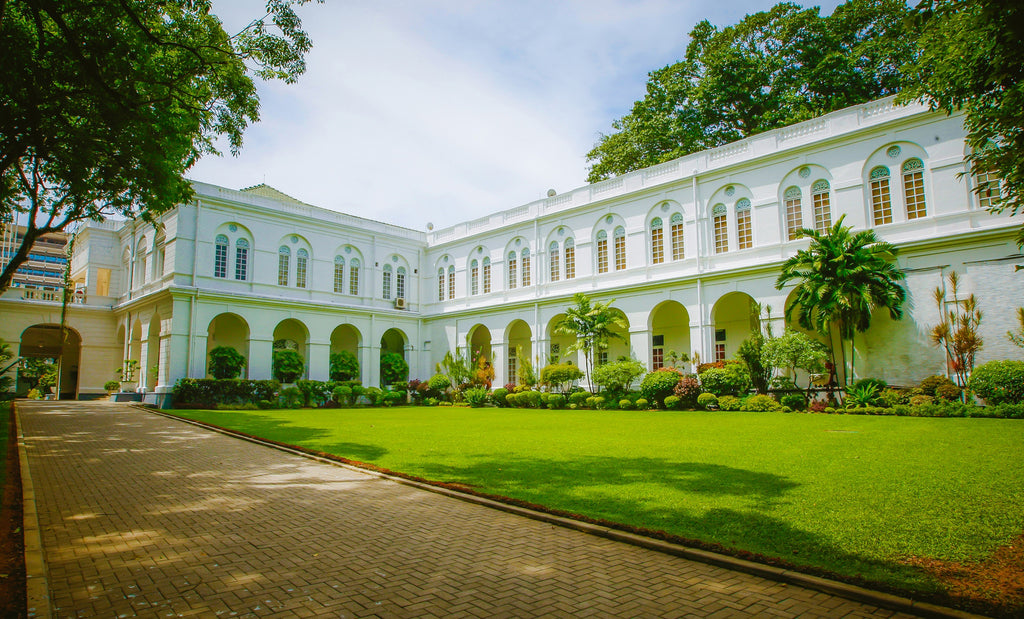


The President’s House played several roles during its past. During the Portuguese rule from about 1505 to 1602, it served as a shrine but it was eventually transferred into a Dutch Church as the Dutch powers came into play. Jerald Van Angalbeek, who was the Dutch Governor from 1794 to 1796 constructed a new building upon this premise and named it the Governor’s Palace. Its ownership gradually vested itself to the British government upon their arrival to this island nation and became the residential palace to the first British Governor, Sir Thomas Maitland. As it changed hands across 29 succeeding British governors, prime ministers and local executive presidents, it was renamed the President’s House and remains a premise for conducting official presidential work and diplomatic missions.
At Elizabeth Jewellers, we love our cultural history as much as you do! That’s why we’ve got a few quaint and elegant sapphire jewelry for you to wear during your visit to this lovely landmark of Colombo. Our first suggestion is this stunning natural white sapphire princess ring in 18K white gold. It holds a large table to expose a perfect and vibrant precious gemstone of brilliant clarity and shimmer. Surely, the eyes that gaze upon the Portuguese designed verandahs and arches won’t miss this beauty!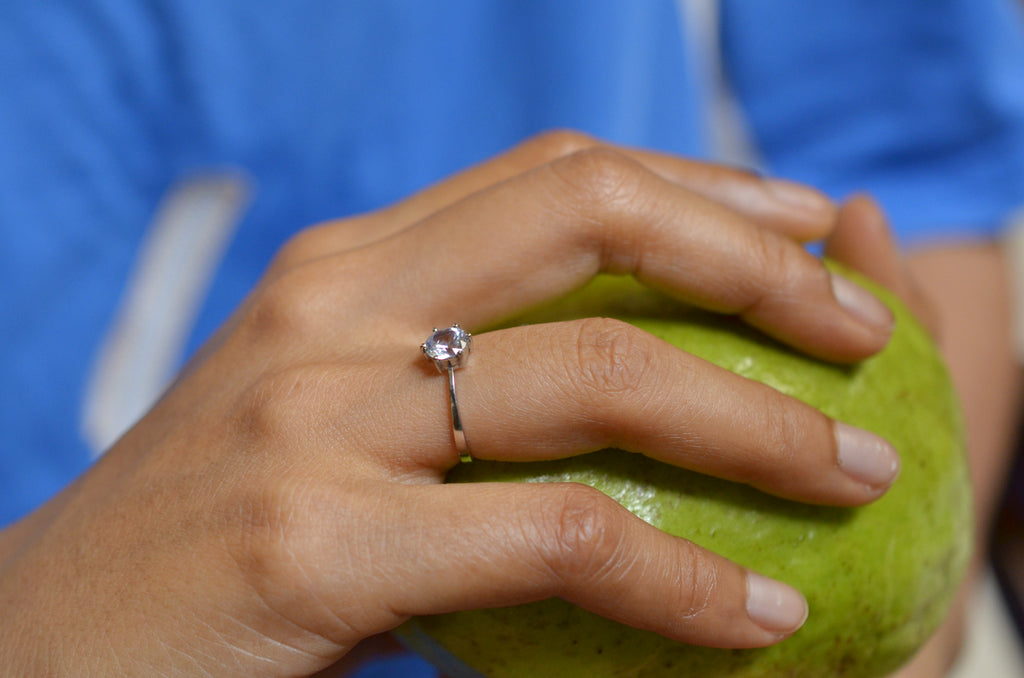
Our next suggestion is a lush Ceylon blue sapphire ring featured in a solitaire 18K white gold setting. Its quaint, simple and truly magnificent design is a testament to the natural beauty of Ceylon sapphires and will suit well to this historic occasion. Its available from 0.5 to 1 carats and we recommend the dark blue hue to add a little ‘umph’ to its brilliance. Feel free to contact us at any time with any questions you may have and we’ll be glad to help! 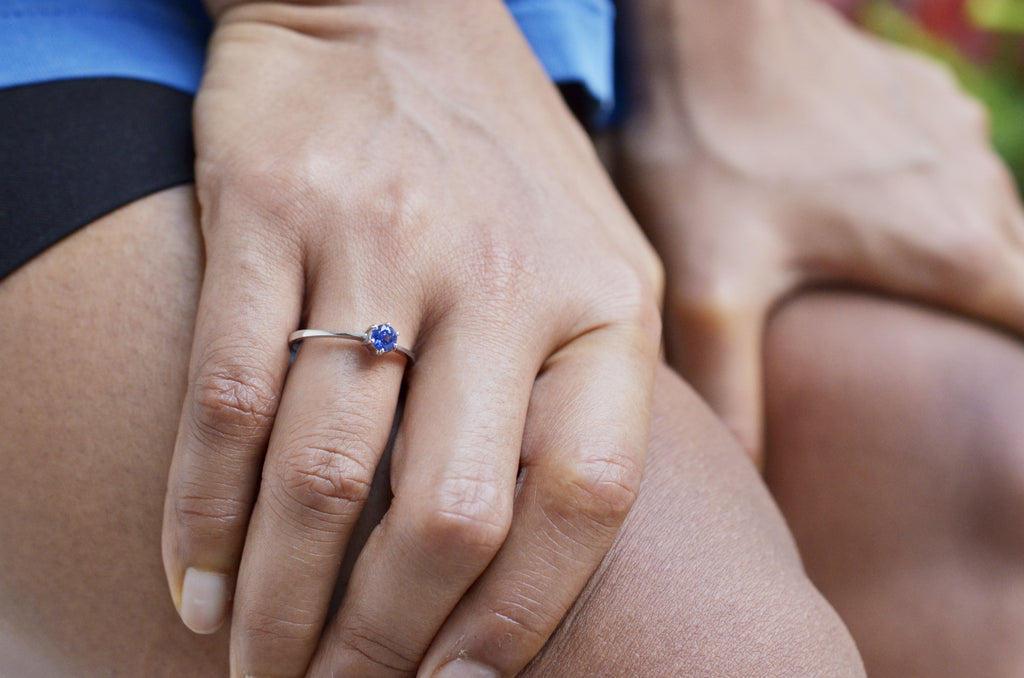
Affordable Sapphire Jewelry June 05 2016
Jewelry prices are not always pretty to look at. Sure, you found a beautiful princess cut ring or a star studded earring that looks absolutely amazing but the price tag, agonizingly, makes you put it back. As you stare at its shimmering beauty, you wonder, why is this so expensive? Why tease me and shun me away with those exorbitant prices? Well, at Elizabeth Jewellers, we got a solution for you! No more tears, no more heart aches. If you find your favorite fashion statement, you can be sure to find the best price available for it at our online store!
Directly from source
How do we guarantee the best prices for our jewelry? Well, we’ve got a well-established and direct link to all our core resources, especially sapphires! Being located in Sri Lanka and having started up in Ratnapura, ‘The City of Gems’, we have a direct line of access to the infamous Ceylon Sapphire. The natural gems we source for all our jewelry are obtained from the locals of Ratnapura. Decades of close relationships and teamwork enable us to find the best sapphires with rich color, great weight and perfect clarity.
The power of the internet
Our online store enables us to reach our clients on a global scale with ease. Each point of engagement without a corresponding investment in inefficient brick and mortar stores helps us to save money! These savings are passed on to you and the end results are jewelry prices that are incredibly affordable. Our online design layouts and product listings are displayed in a simple and user friendly manner to enhance our customer experience so that you can shop comfortably and conveniently with your fingertips. Our store’s integration with PayPal and SSL certifications help secure our website for a safe and private shopping experience so that your information is kept safe and protected from intruders.
Directly to you
Another great feature of our online store is that it enables you, from anywhere in the world, to place an order for jewelry straight from the heartland of sapphires! No dealers, no third party retailers, basically, no middlemen at all. With this comes an elimination of price markups that arise through the progression of market intermediaries. With a reduction in unnecessary price increases, you get the best value for your money. With fully insured shipping guaranteed at every purchase, you can be sure to have your favorite jewelry be delivered straight to your doorstep at the finest quality of craftsmanship we have to offer.
The world is at your fingertips, so make the smart decision! No longer do you have to burden yourself with the unfair prices of main street retailers. To make matters easier, here’s a peek into one of our best sapphire rings. It features a beautiful oval blue sapphire in an intricate 18K white gold box prong setting. It has been a favorite among our clients for commemorating their engagements and their lifelong love for each other. And, yes its price is incredibly affordable for a natural precious gemstone. Don’t miss out!
Summer Fashion & Sapphires May 30 2016
Bright sunny days, 80-degree weather and a light breeze signals nothing more than start of another wonderful summer. Gazing into the pastel blue skies and listening to the slight sway of branches overhead grants a beautiful serendipity and appreciation for the world we live in. That of course, warrants surfing Pinterest for more lovely sunnies! Off the shoulder greens, white casual chics and citrus sleeve dresses are indeed some of my favorite but don’t take my word for it, have a look for yourself and let me know what you think!
These beauties look simply stunning but they do need a few elegant accessories to match. Yes, when you can stretch right up and touch the sky, there’s nothing more you need than this yellow and white sapphire eternity ring. The highlight of this ring is by far its bright and lush color! The rich hues of Ceylon yellow sapphires add a vibrant touch that perfectly complement the summer colors of these dresses. Perfectly aligned in an 18K white gold setting, this eternity ring also features white sapphires as its original design. Fortunately, Elizabeth Jewellers also grants the availability of this ring in brilliant diamonds upon request.
Life’s for living, so when the weather is fine go out and enjoy yourself! Even with the beautiful weather ahead, we’ll always be here to answer any questions you may have. Feel free to contact us at any time and we’ll be glad to help you out!
For a full 360 degree view of this eternity ring click here!
Sapphires At Saint Devote May 29 2016
If by fortune, you have found yourself basking in the afternoon sun of the Monaco Grand Prix, you will of course be up for a great race weekend! Whether you’re in a high rise apartment through Sainte Devote or a custom ultra-luxurious Benetti yacht overlooking the Nouvelle Chicane, the roaring Formula 1 beasts are bound for an epic and close fight to the checkered flag. In between free practice, qualifying and partying, you will have plenty of opportunities to showcase your glitz and glamor among the rich and famous and what better way to entrance them than with your natural sapphires!
Our recommendation is the masterpiece of our jewelry collection. It features an absolutely beautiful 18K white gold ring with four rows of lush blue sapphires. To be exact, this ring presents 88 Ceylon blue sapphires for a combined weight of 7.7 carats. The paved setting enables each of the sapphires to form a stunning halo around your finger that is guaranteed to glisten as magnificently as the Mediterranean Sea beside the street circuit of the Monaco Grand Prix. The real beauty of this ring is its consistency in color. Each of the 88 sapphires are hand selected, carefully sorted and precisely mounted by our master jewelers. Achieving this consistency and quality of craftsmanship takes as much passion, dedication and skill as the Formula 1 drivers and we are proud to deliver results each and every day!
You can order this simply elegant ring by visiting our online store here, and we’ll deliver it straight to your doorstep!
Blue Sapphires: The Oval Design May 26 2016
The iconic Ceylon blue sapphire has been a favorite to be featured in precious gemstone rings for many generations. The vivid blue hue emanates a passionate shimmer across the eyes of men and women across the world as it embodies a character of love, wisdom and strength. A recent client once discussed with us the incredible endeavor she endured with her husband during a period of financial and personal struggle. Happily, they managed to overcome several obstacles in their beautiful life together and the love that brought them to each other glowed ever brighter. We could literally see the budding happiness in their eyes and smiles as they talked to each other and could not be more honored to buttress their strength in love and character with a lush blue sapphire ring.
What a challenge we had! We needed a design that perfectly reflects their story of love through times of good and bad. It had to be something that was simple, something with a burning strength and yet remained elegant and cool. Our journey began with the selection of natural sapphires straight from Ratnapura, the ‘City of Gems’ located in Sri Lanka. These gemstones are of the finest caliber known to man and it had to be in order to embody the relationship held by this brilliant couple.
We chose a special oval cut for our blue sapphire and its size remained at a comfortable 1.5 carats. The 18K white gold band that held this oval blue sapphire featured two semi bezels. It was quietly indicative of their combined effort and strength to sustain a relationship pure of love, compassion and care for each other. The simplicity of the design paralleled a lean lifestyle yet its elegance exuberated a passion to strive forward and become poised for success. At Elizabeth Jewellers, we design our jewelry with the stories of our clients in mind and each one is as special as the other. Feel free to contact us at any time if you need a custom design and we’ll be delighted to help!
Sunny Summers & Sapphires May 22 2016
Ah, it’s that time of the year again! A little excitement and energy never fails to come round when the paltry warmth of spring grows to a full-on summer heat. Whether you’re gearing up your floppy hat for a fun beach day or a floral halter dress for a relaxing picnic with your best friends, a piece of sapphire jewelry can always add a touch of elegance and radiance to fit the occasion.
Decided on a tropical getaway this summer? Perhaps the island of Sri Lanka? Oh, how exotic! Let me first congratulate you on choosing one of the world’s best vacation spots. The sublime shores of Arugam Bay, the exquisite seafood in Galle and the stunning coral reefs of Trincomalee are indeed some of the best places to experience. Countless novice and seasoned globe trotters have commended the rich culture, history and hospitality of the Sri Lankans but don’t take my word for it, see for yourself!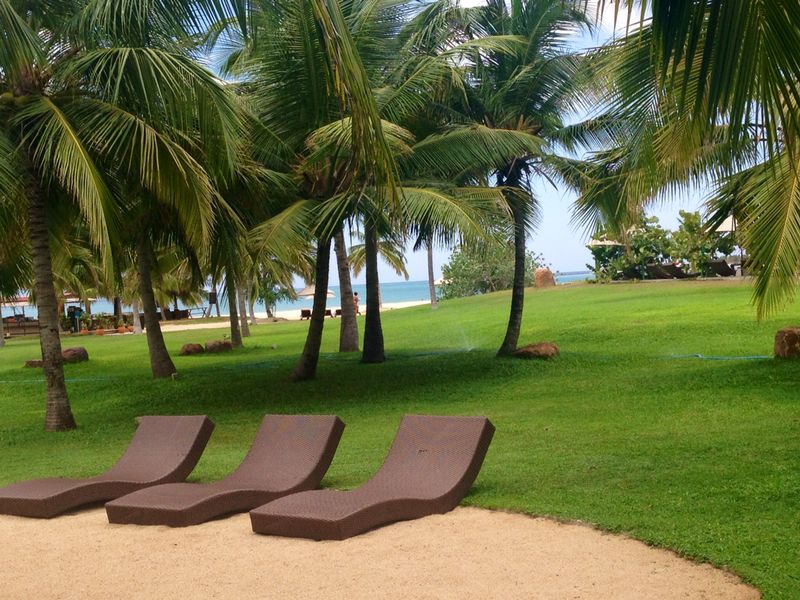

Sure, Sri Lanka is a great place to go visit but whatever do I wear for a day of beaches, sun and sand? My first recommendation would be a beautiful alternating yellow sapphire and diamond eternity ring featured below. Paved in 18K white gold, each sapphire and diamond is hand selected and matched individually by our very own master craftsmen to each ring so that the color and brilliance remains consistent throughout. Its radiance matches perfectly with bright rays of sunlight that will bathe you as you lay on the lounge chairs sipping on your cool and refreshing king coconut!
Maybe an island holiday might not be what you have in mind for this year. Instead, a peaceful, closer-to-home picnic sounds more pleasing to your ear. Home-made goodies, crunchy cookies, fluffy cakes and a flavorful cuppa is an absolute delight! And, we’ve got another stunning sapphire ring to match! Featured below, is one of our favorite sapphire rings. This princess white sapphire presents a wide table that enables maximum light penetration so that its glimmer never fails to amaze. This natural precious gemstone is mounted on an 18K white gold bezel setting and can be easily customized upon request. It’s simple, it’s elegant and it’s everything I could ask for!
Whatever the occasion maybe, you can be sure that we’ve got a sapphire to match it! The pictures of jewelry above are linked straight to our product pages, so you can easily shop anything you find attractive. Summer is coming, so be sure to have a sapphire out and enjoy the beautiful weather.
Custom Engagement Rings May 19 2016
Sapphires come in an assortment of colors and shapes but personally, my favorite is the cornflower blue sapphire. Its deep blue ocean like shimmer gives my heart a little flutter every time I lay my eyes upon it. Natural blue sapphires have been adorned in jewelry for many centuries and have been a highlight among many relationships across the world. It was thus, a pleasure and an honor, to have been given the opportunity to custom design and artfully craft a unique and special engagement ring for a beautiful couple who were visiting Sri Lanka.
Our initial proposal featured a medium blue oval sapphire in an 18K white gold setting that brought out an intense and vivid hue for this special occasion.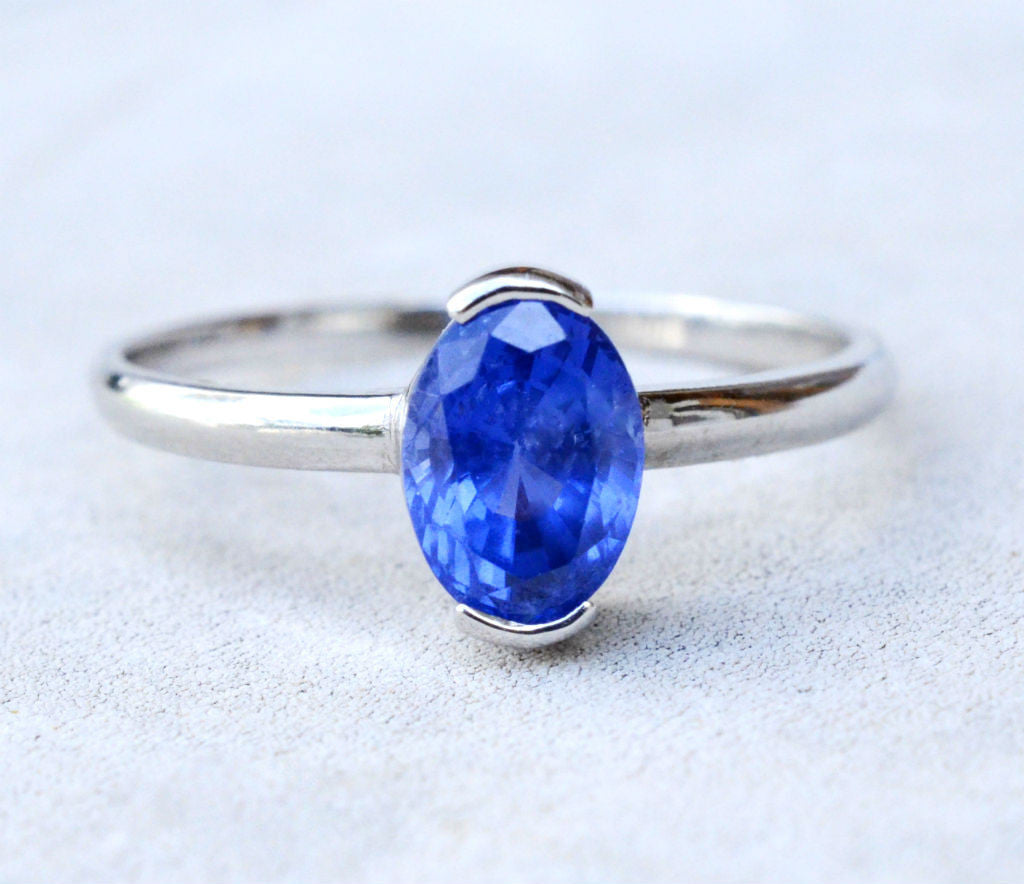
Our client, of course, needed something one-of-a-kind and hence, with the help of some soul-searching, we offered the following design. It featured a 0.75 carat dark blue Ceylon blue sapphire with 2 adjacent white sapphires to beautifully complement the main sapphire. Together, they were placed in an 18K white gold band that gave a stunning glamour to match their special engagement.
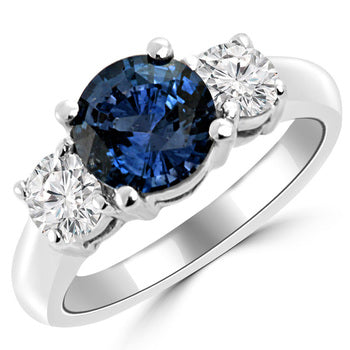
So, with a happy client and even gleeful couple, we were pleased to know that they absolutely loved our custom Ceylon sapphire engagement ring. Here’s a picture that they sent us of their beautiful ring.
- Page 1 of 3
- Next

